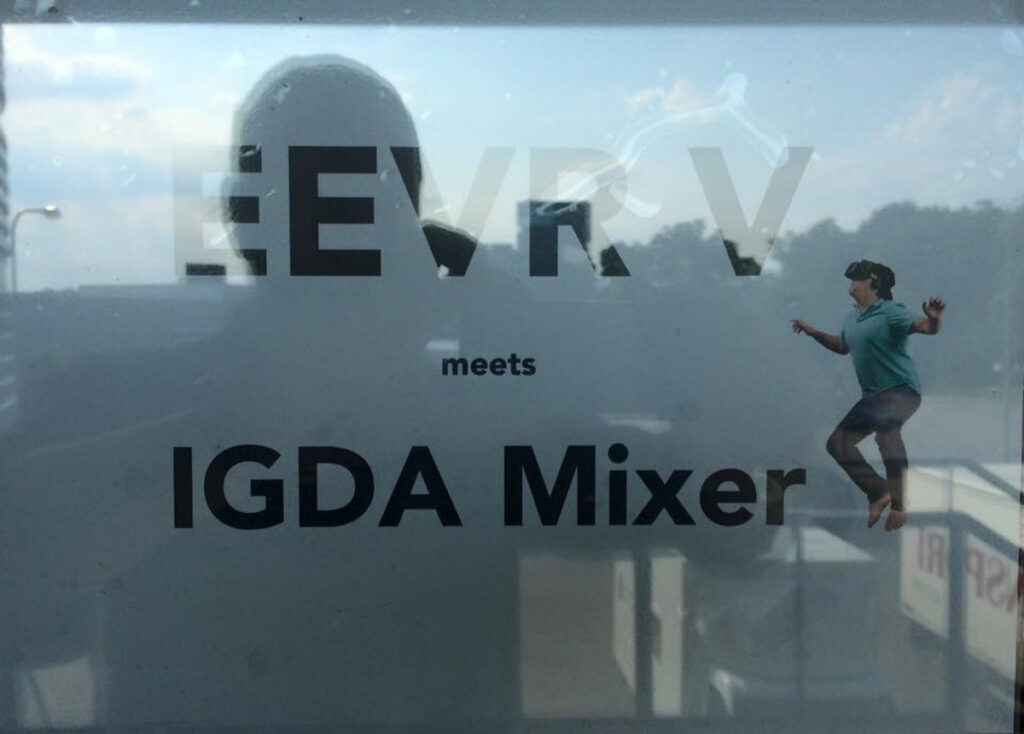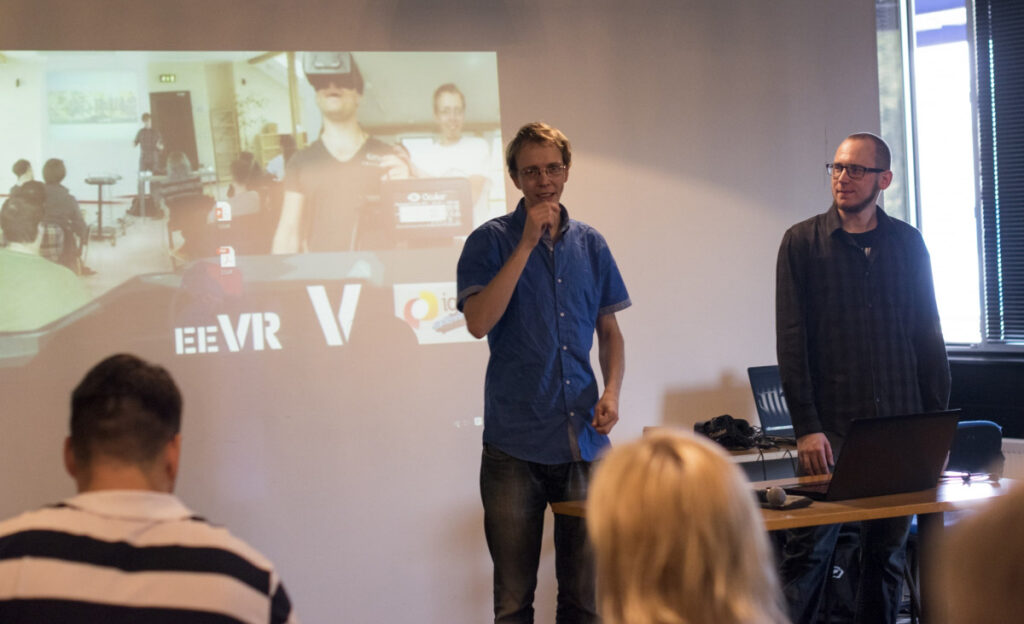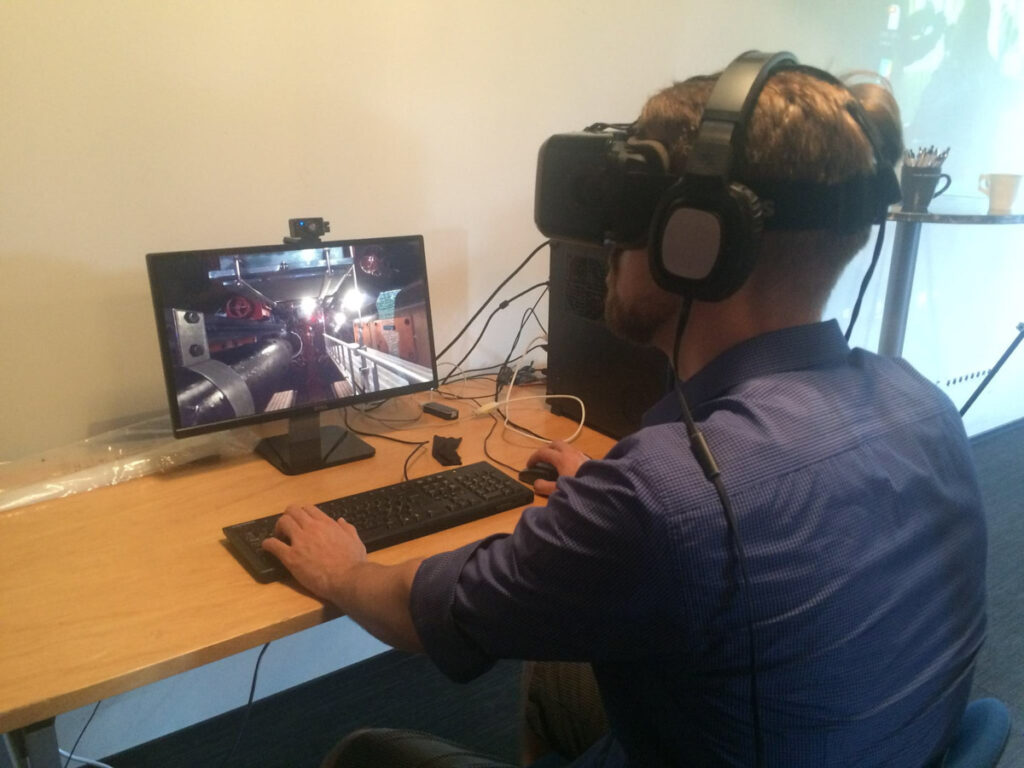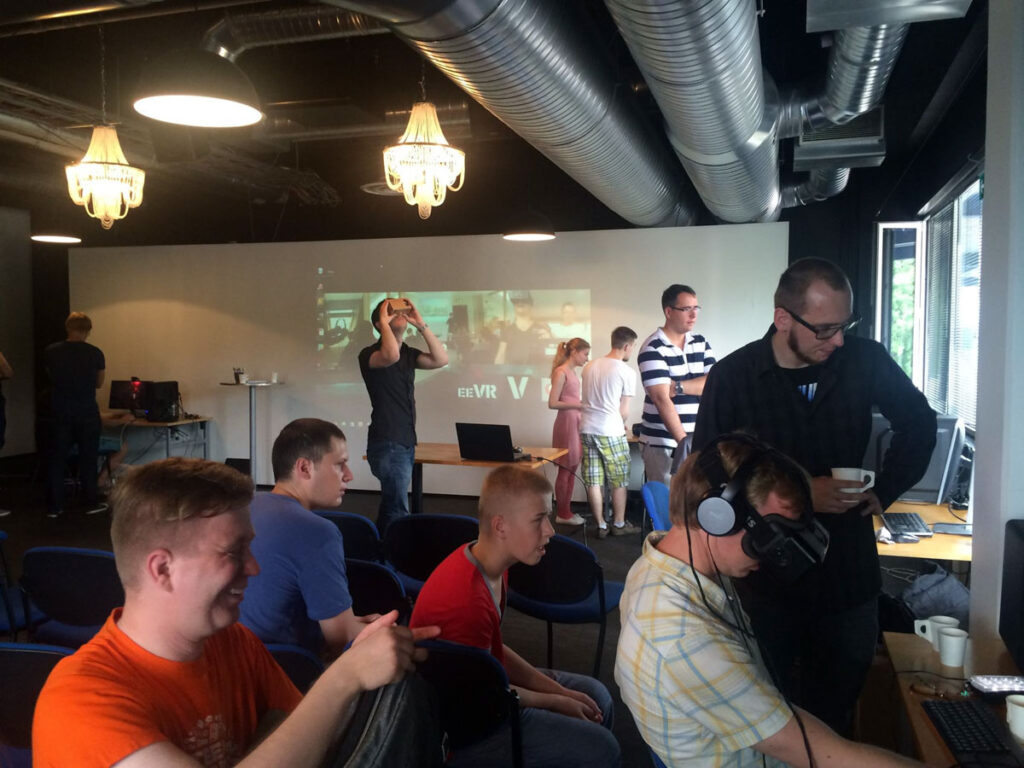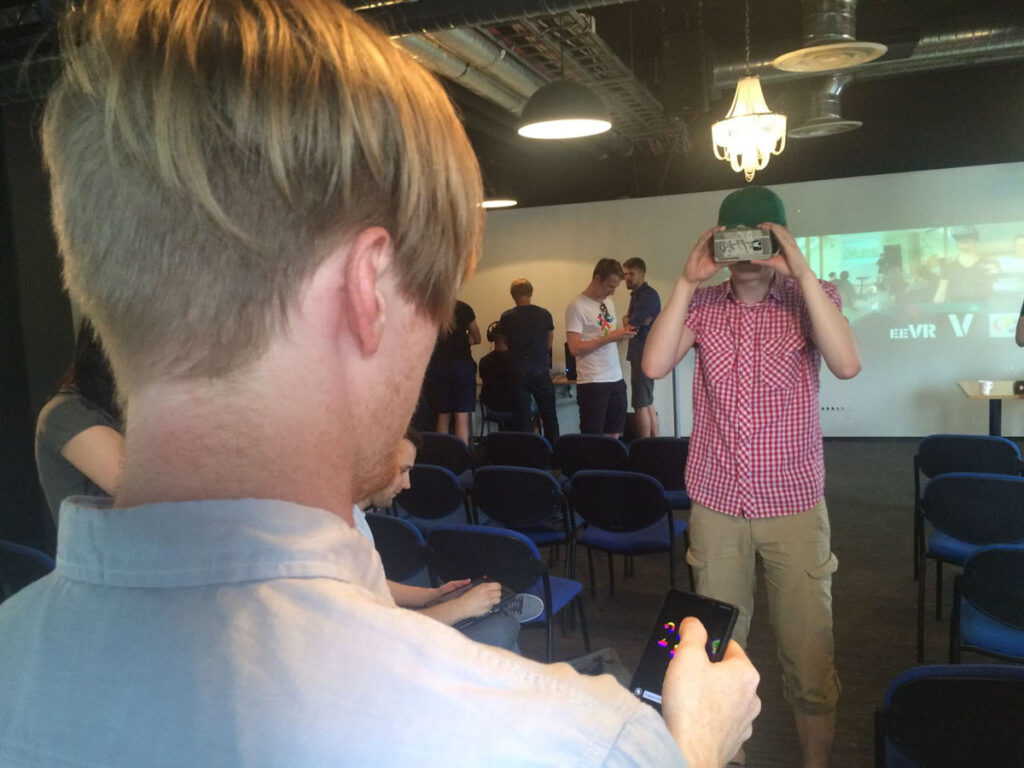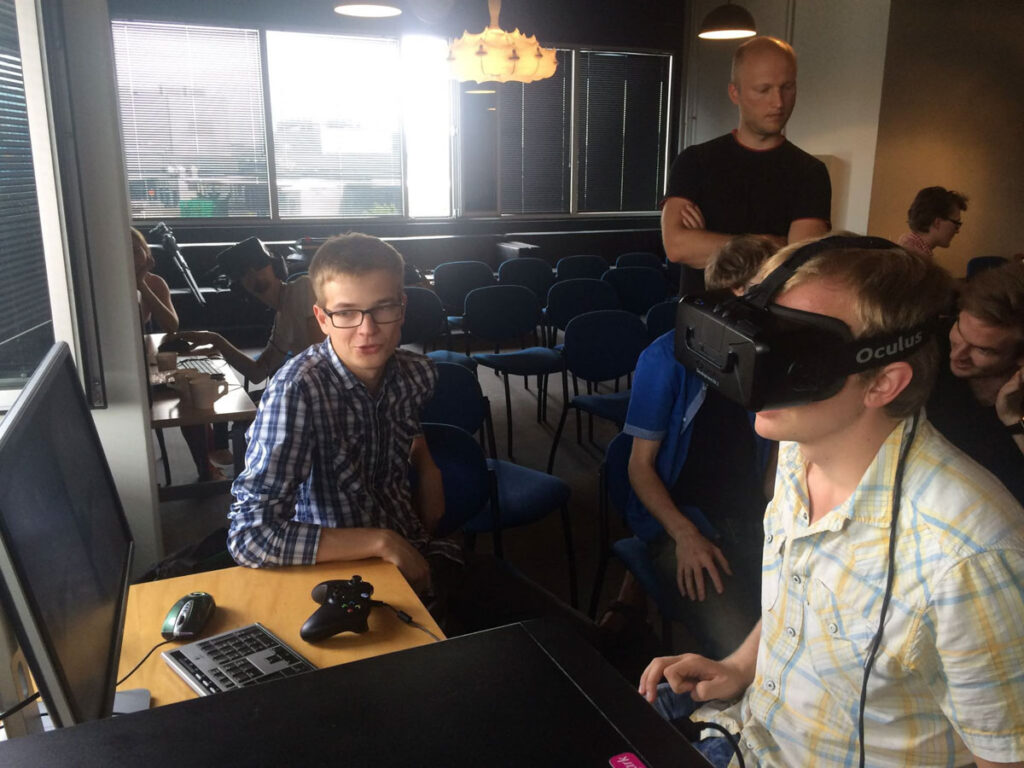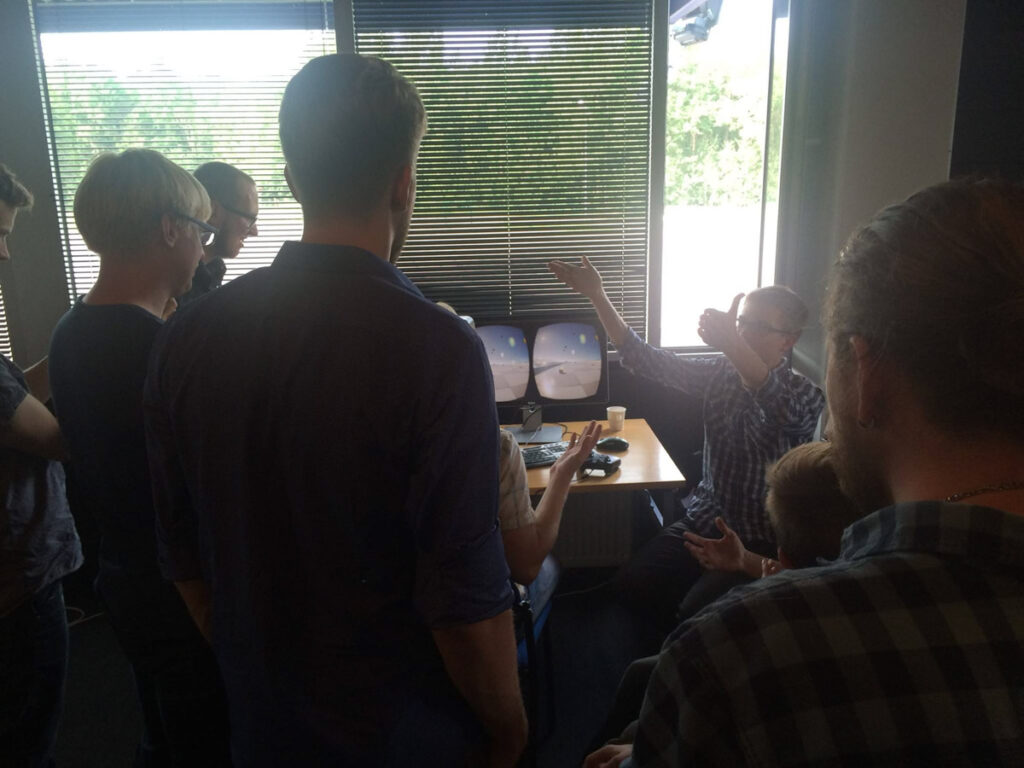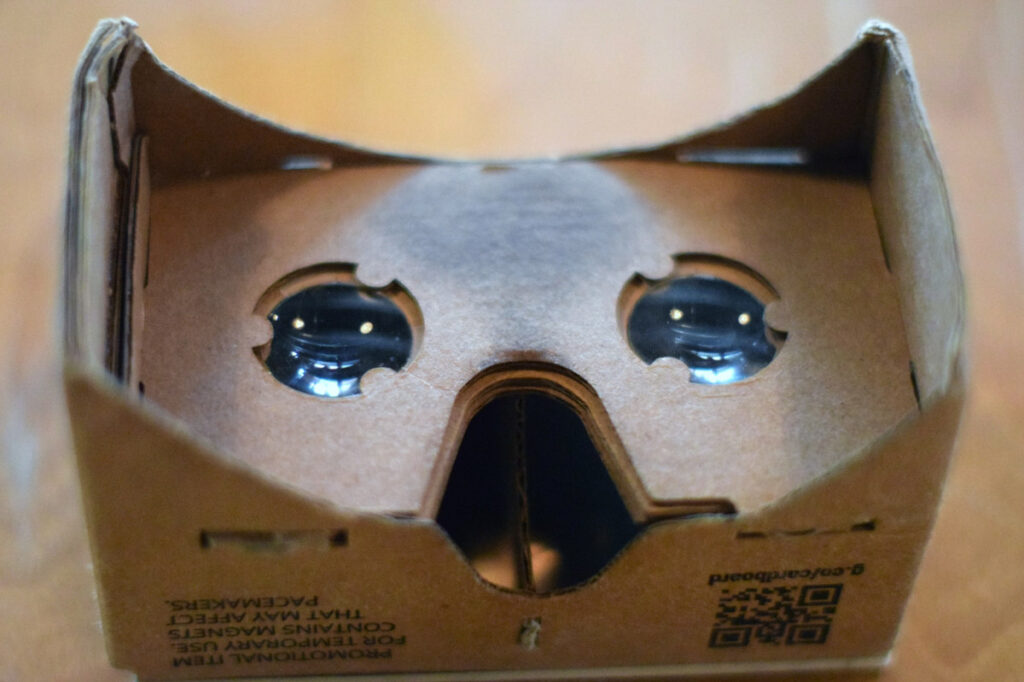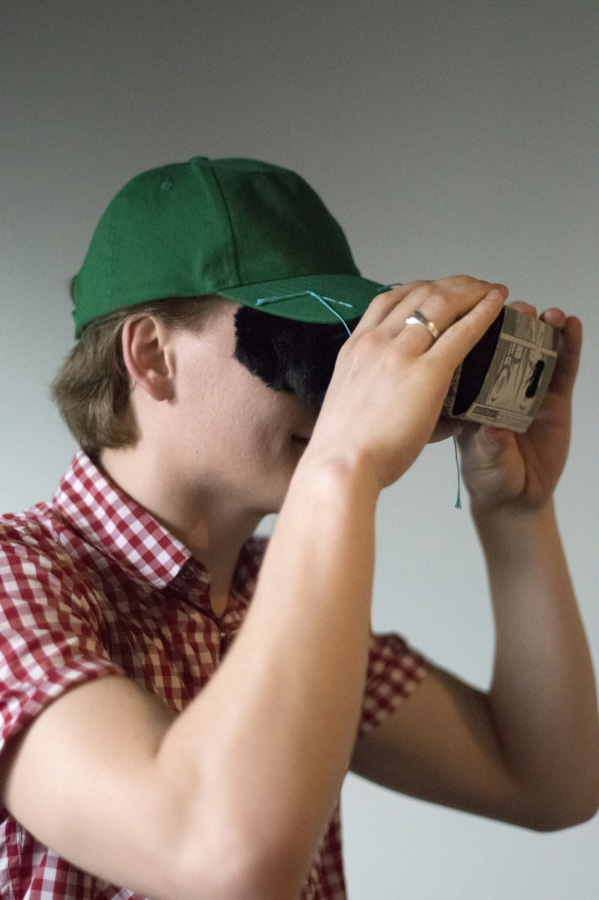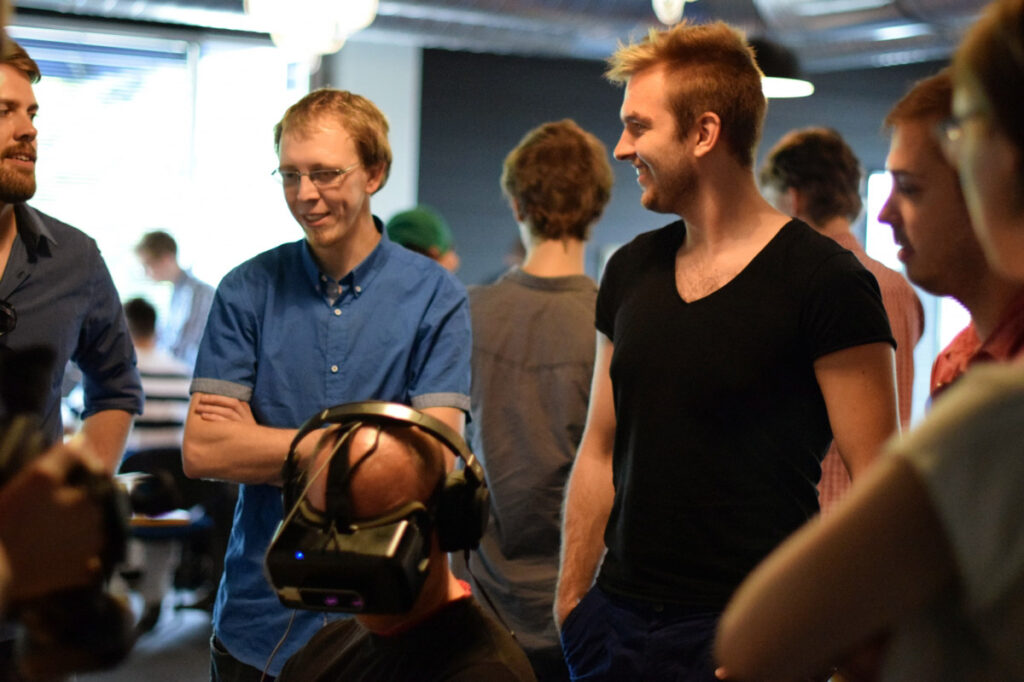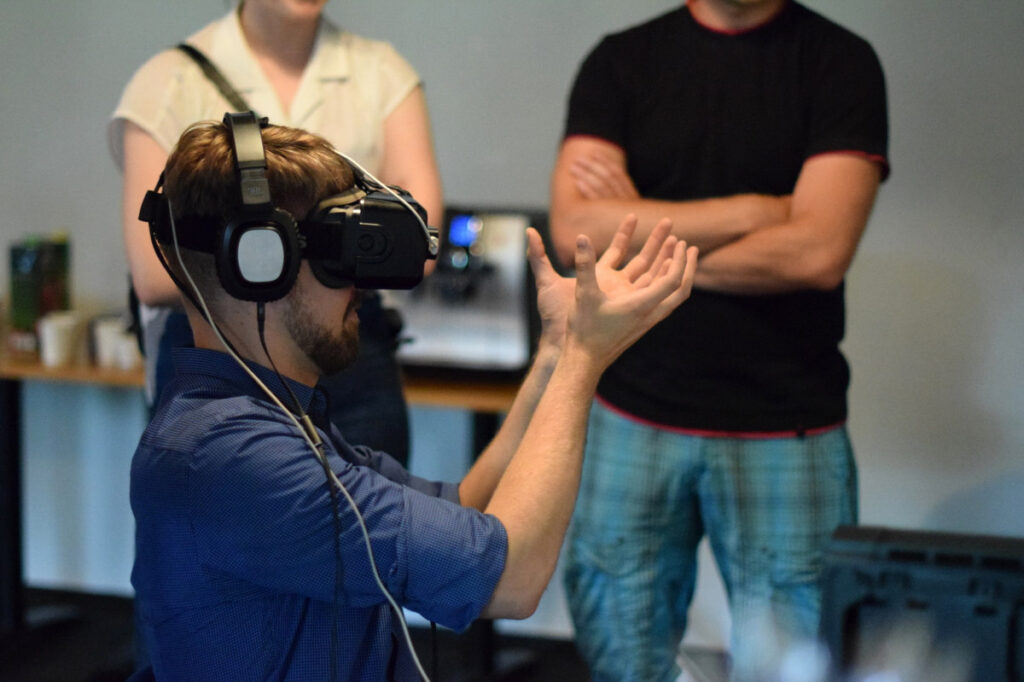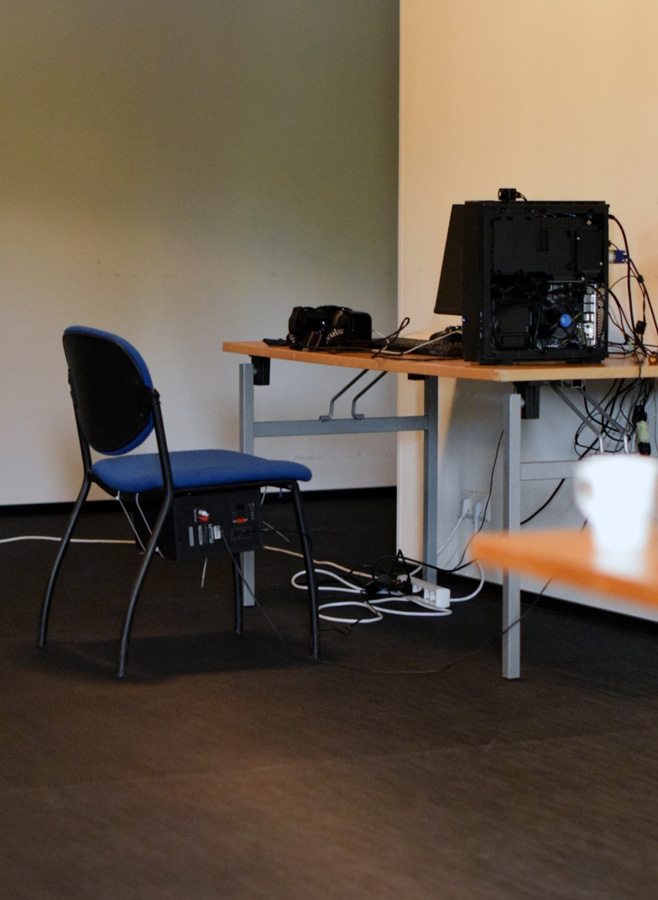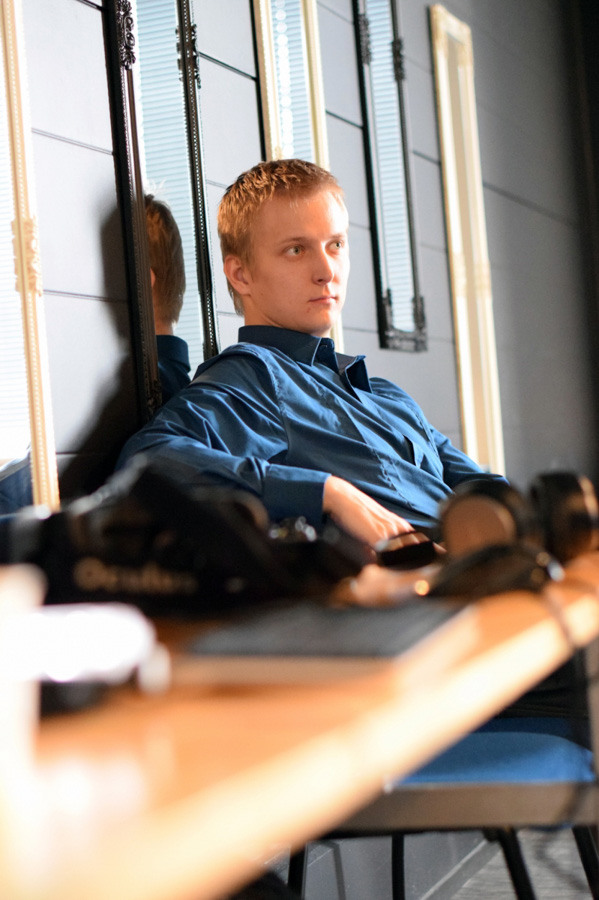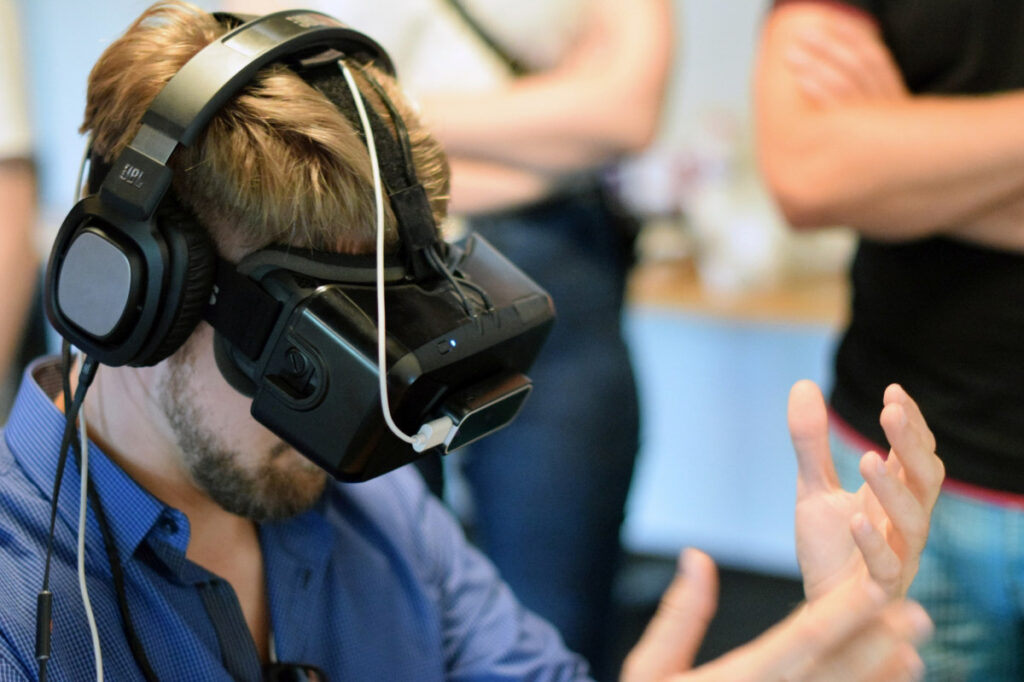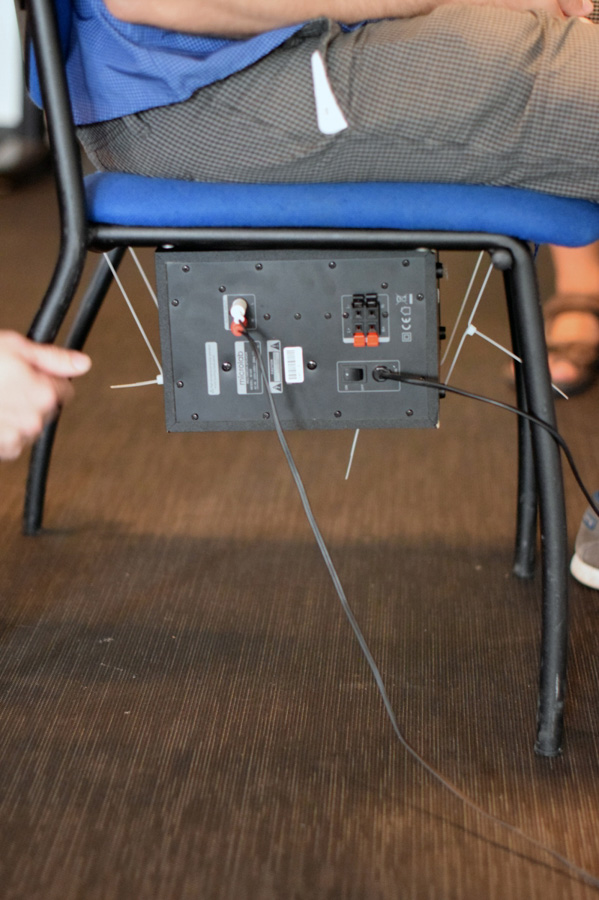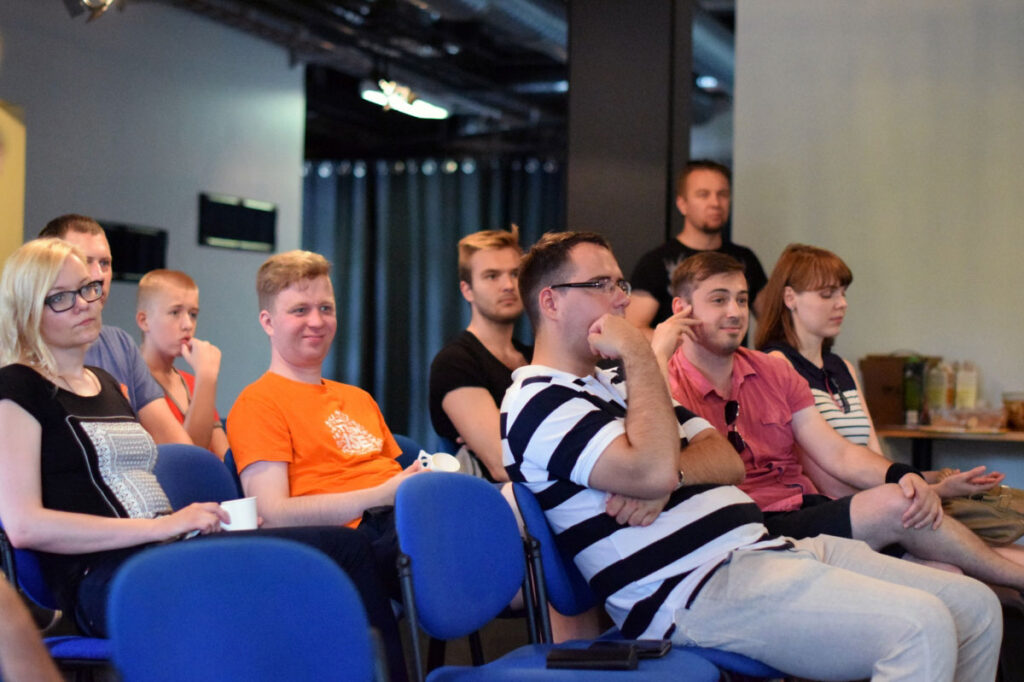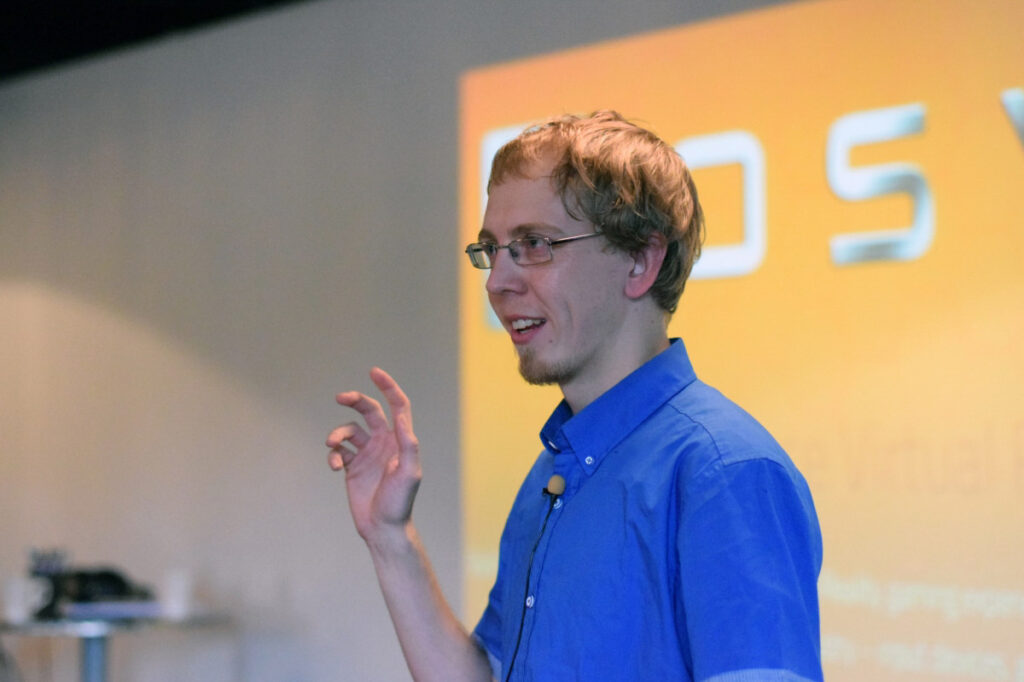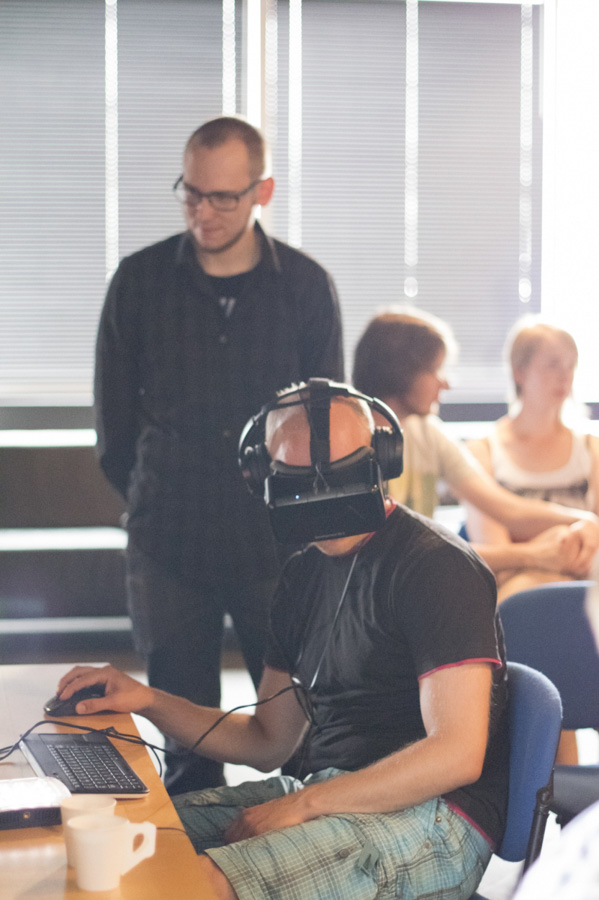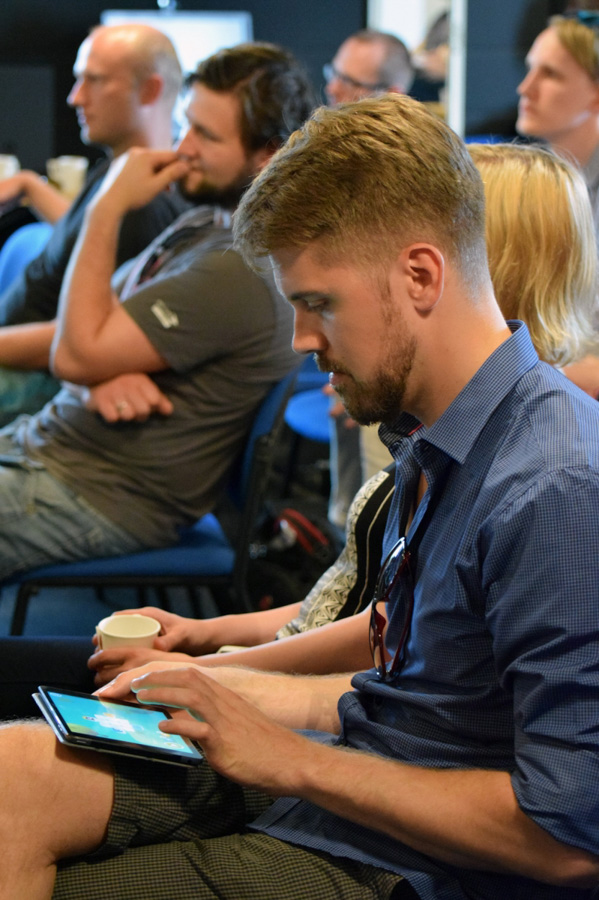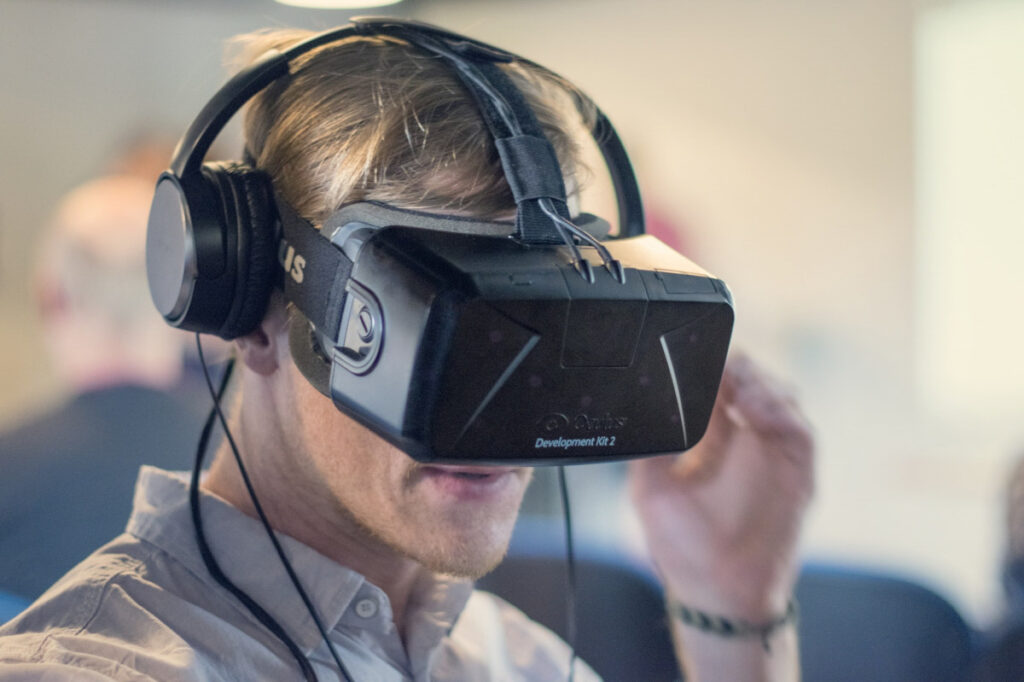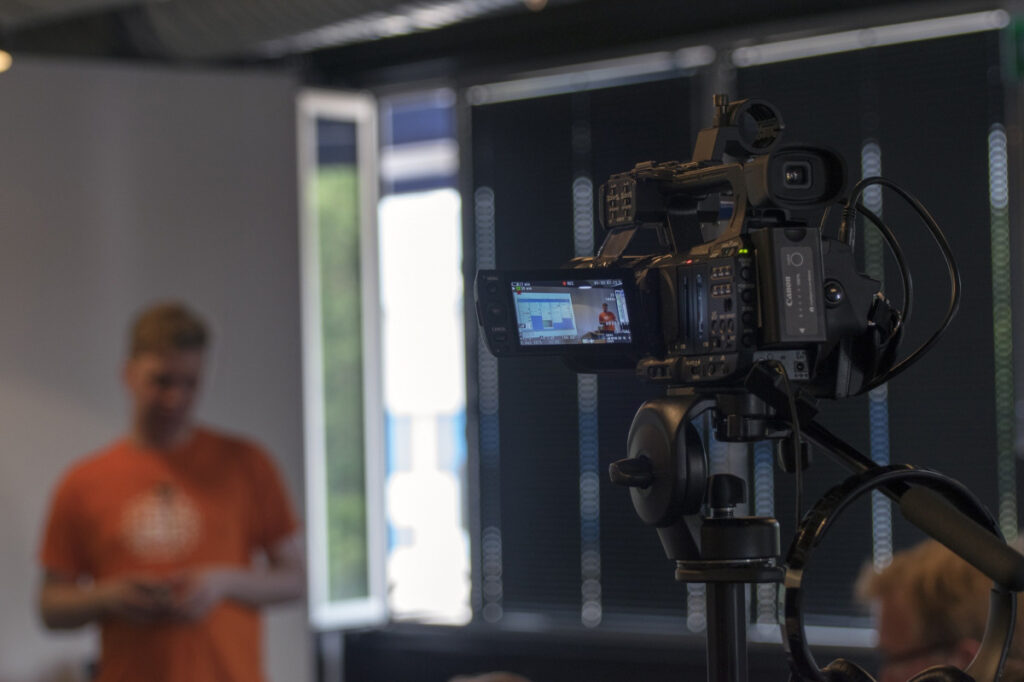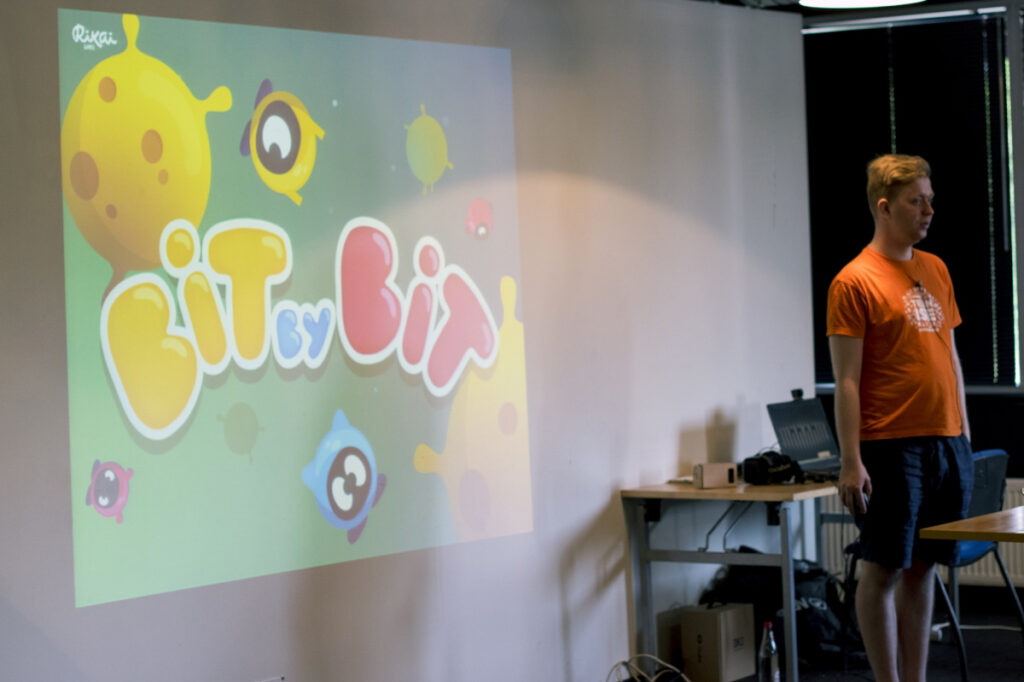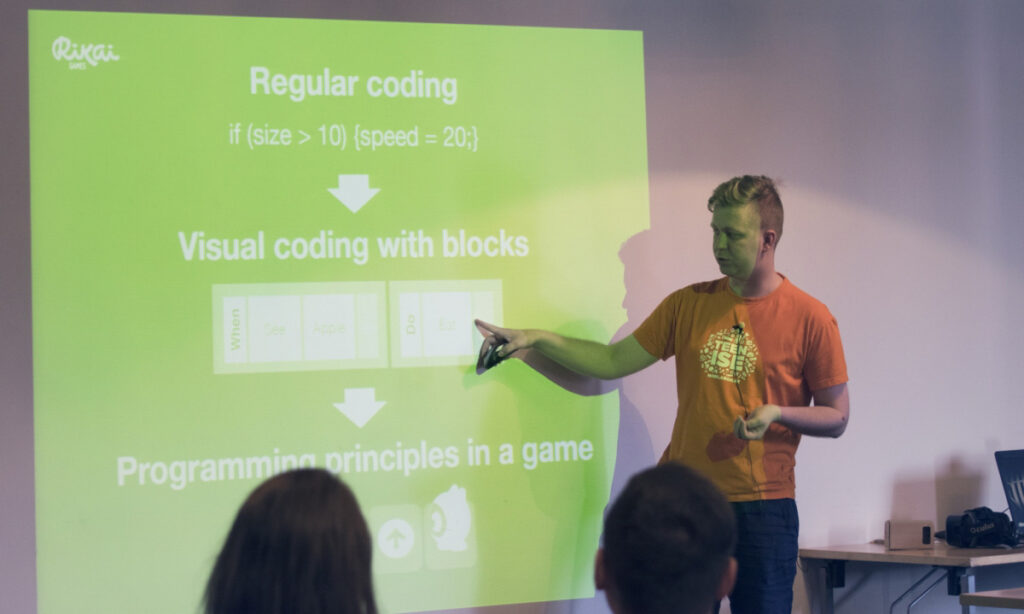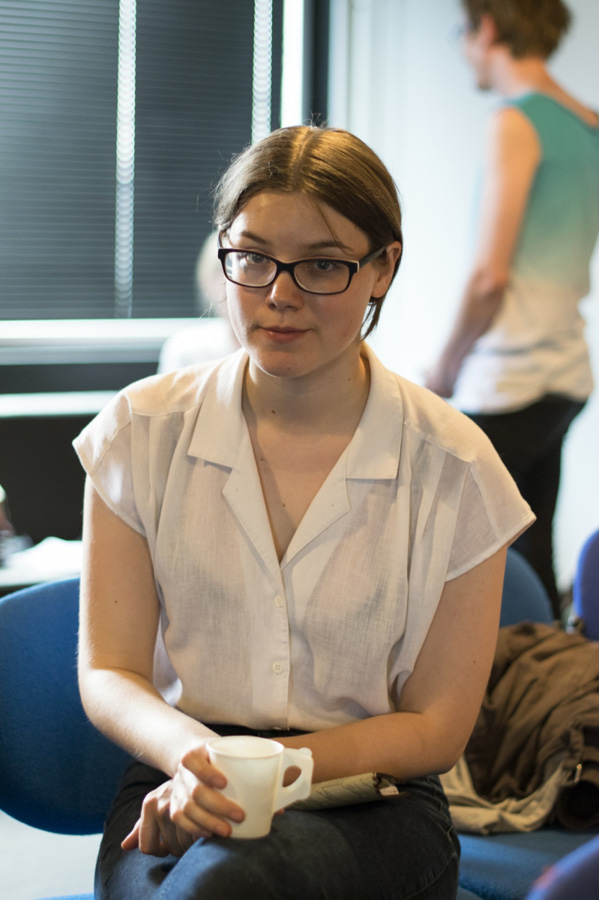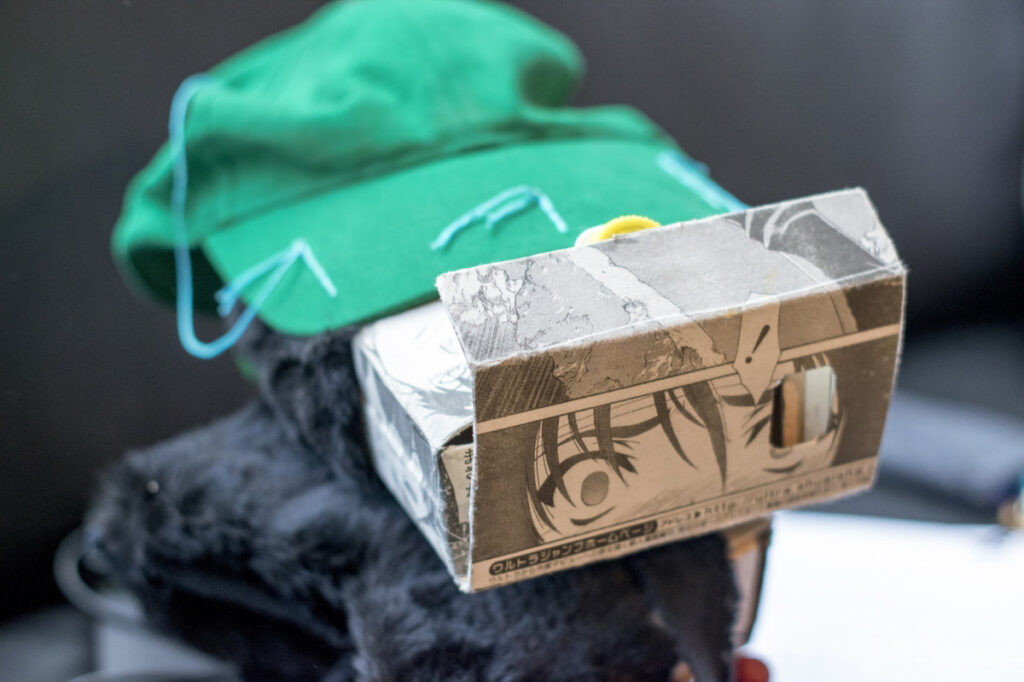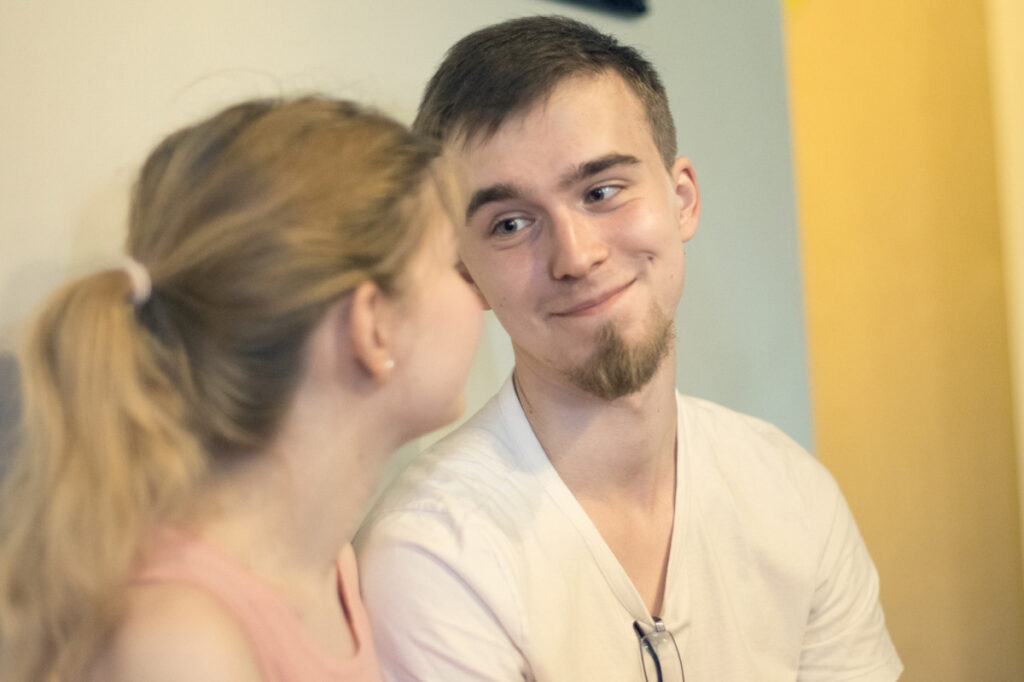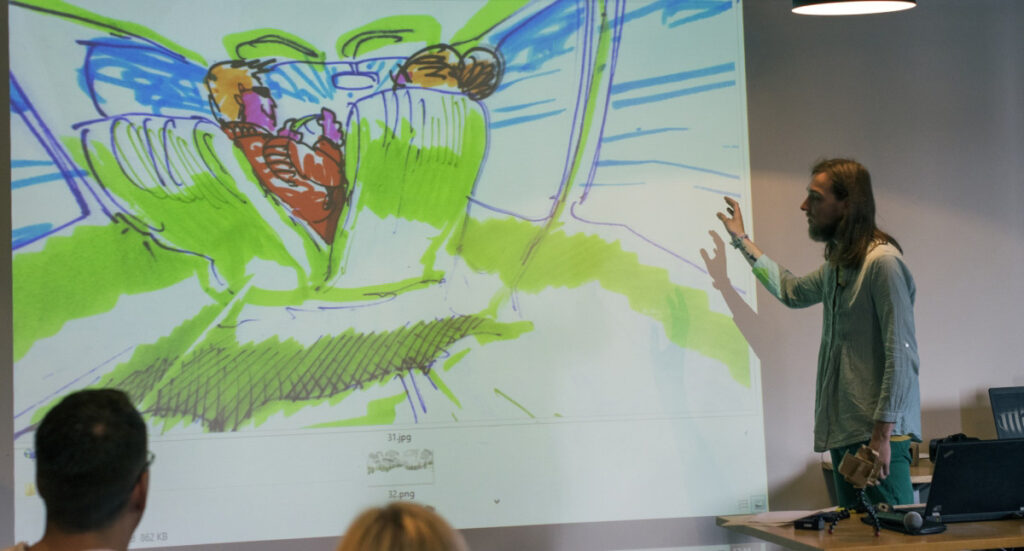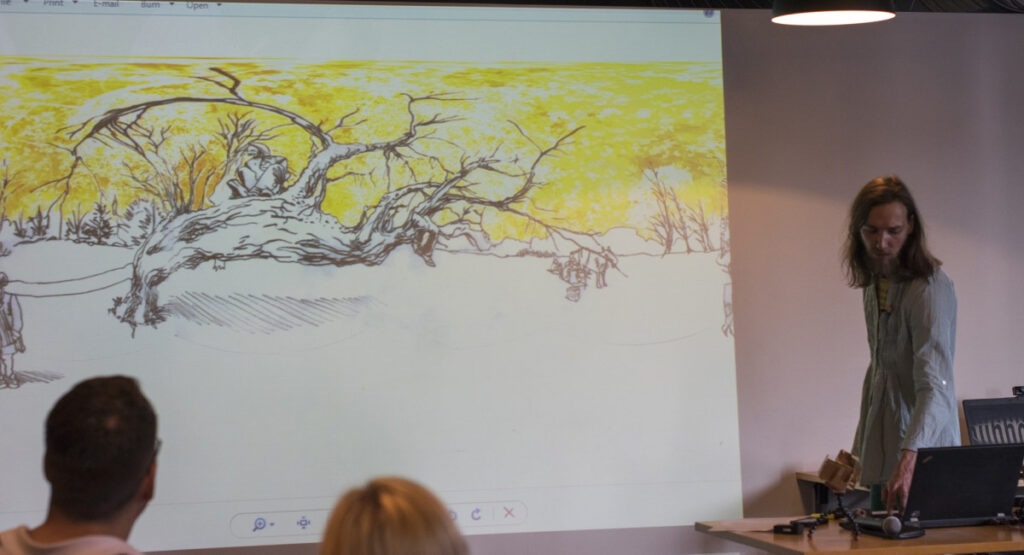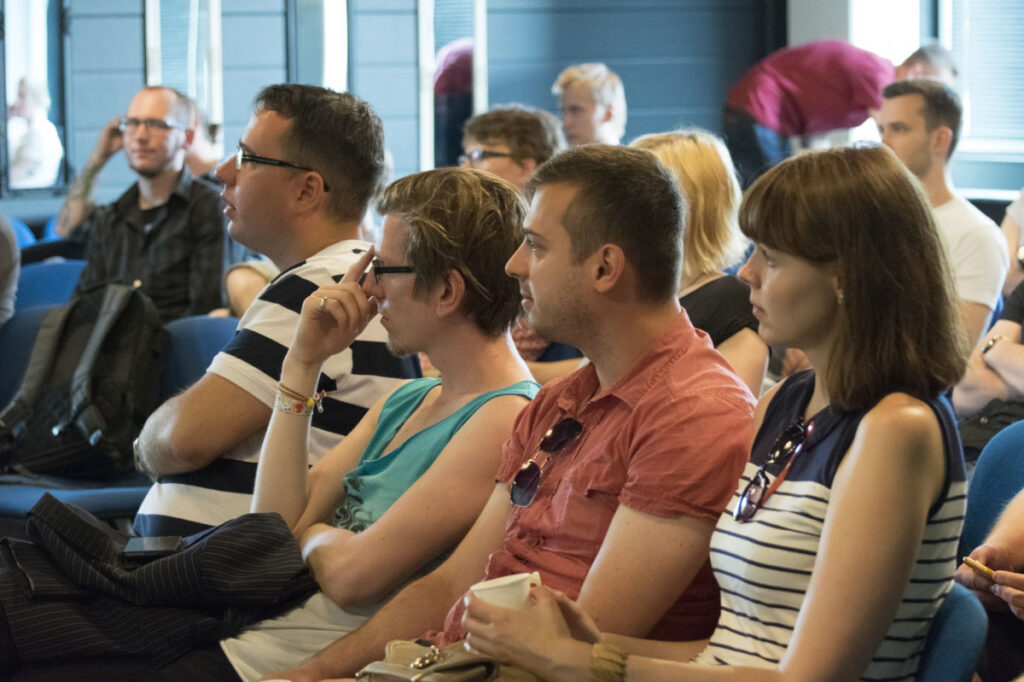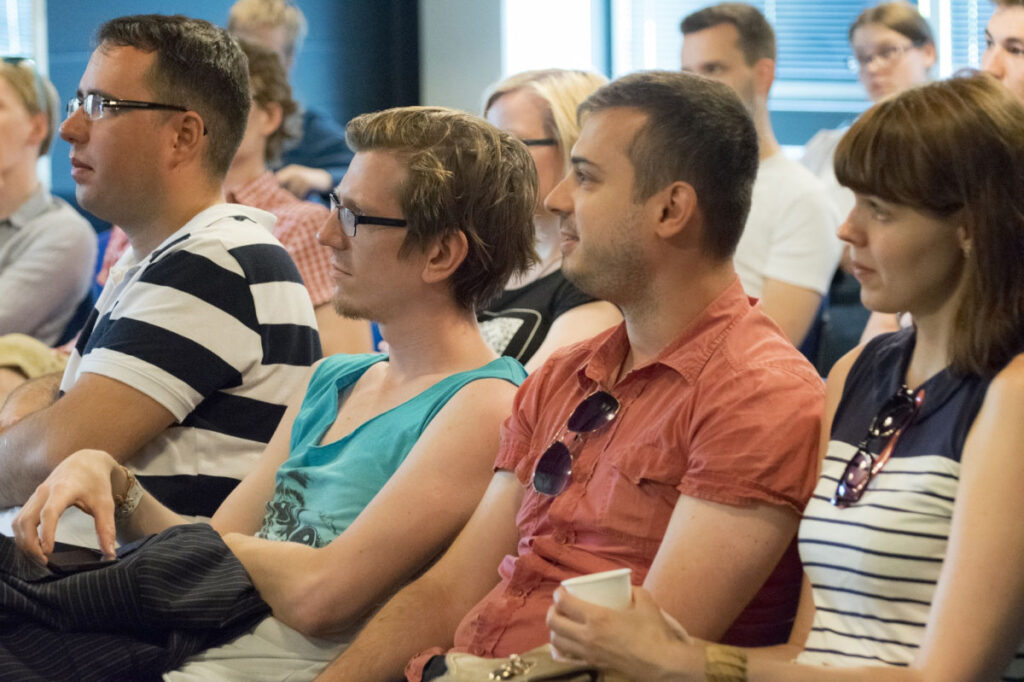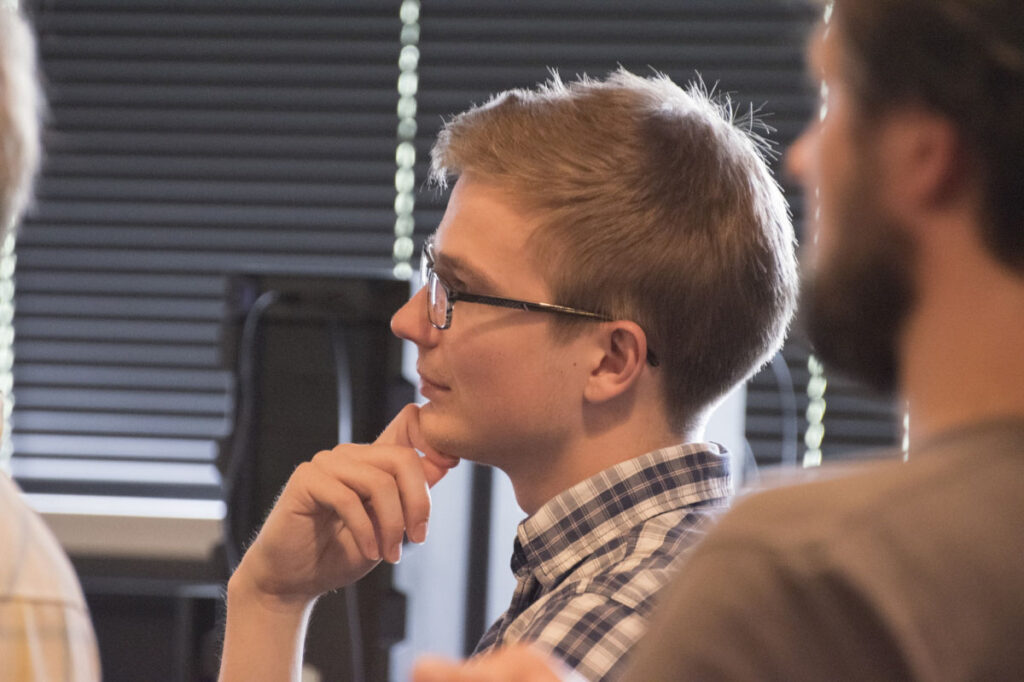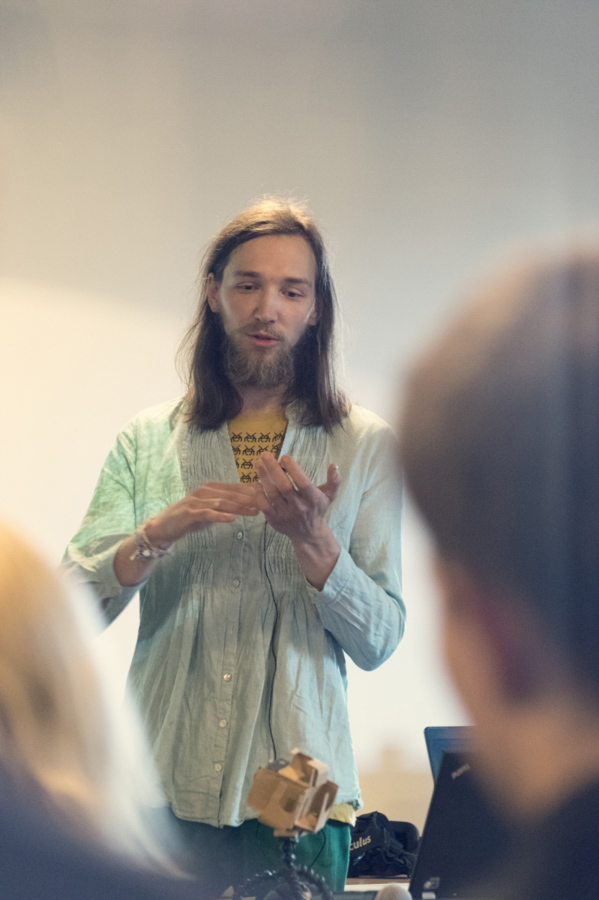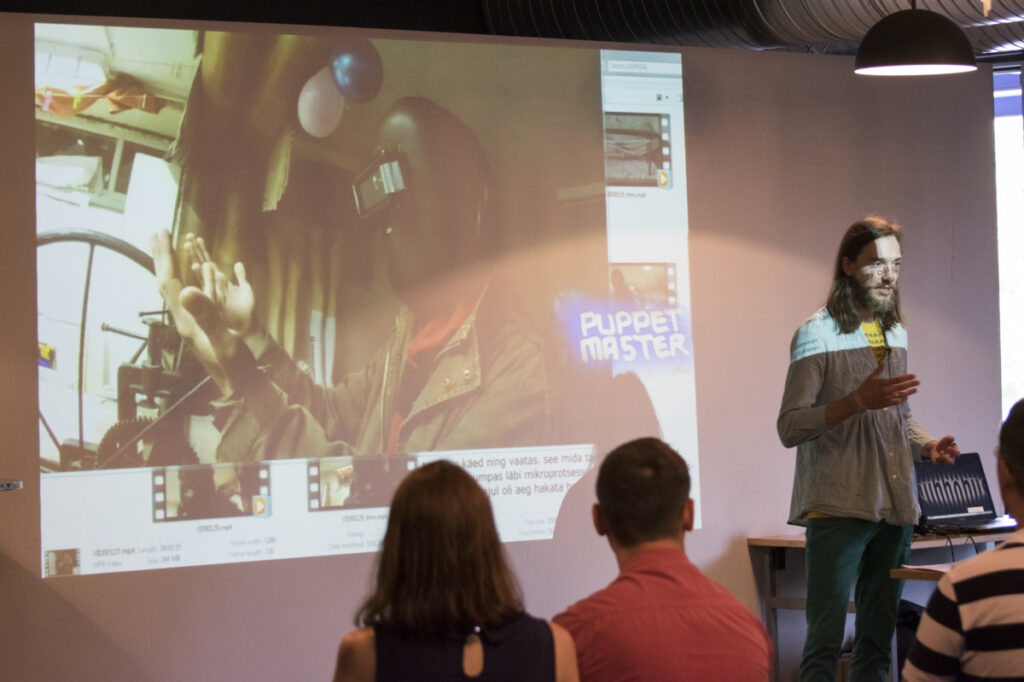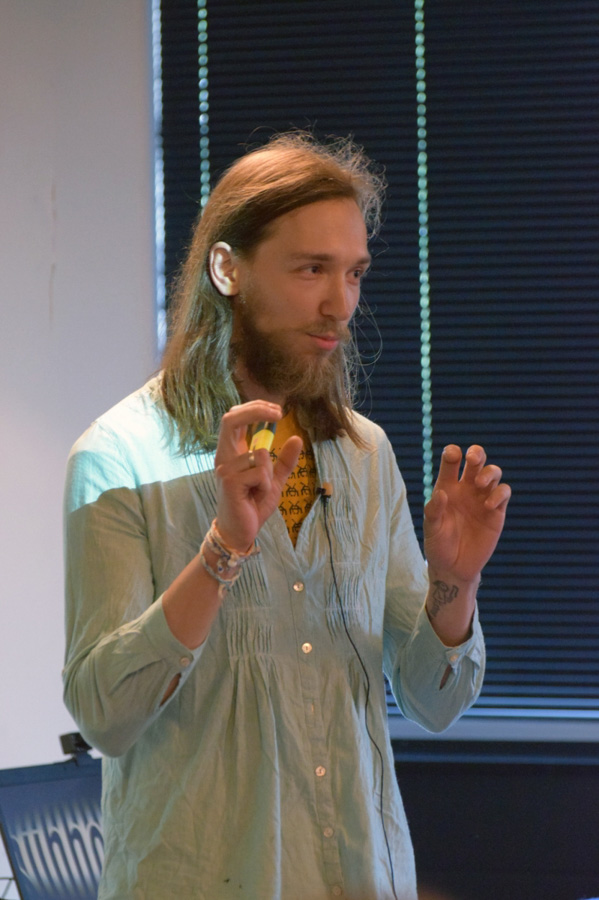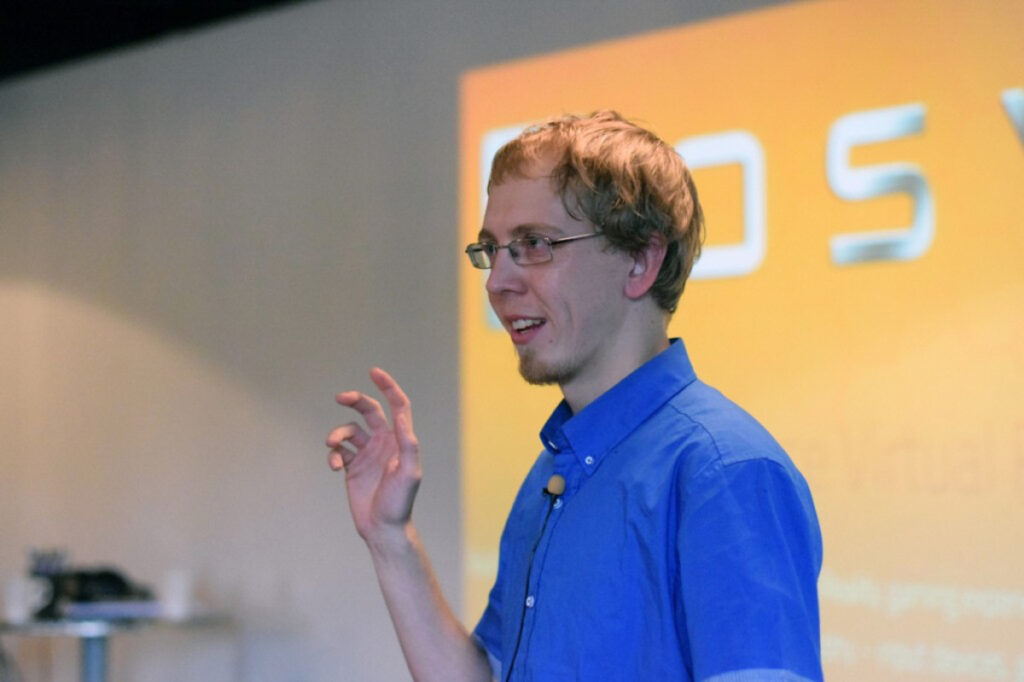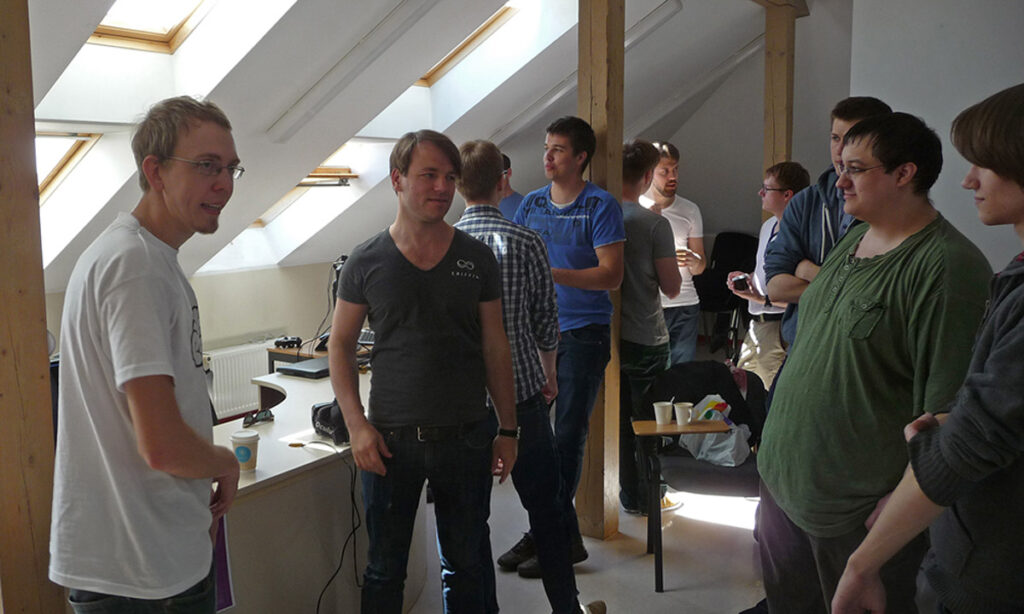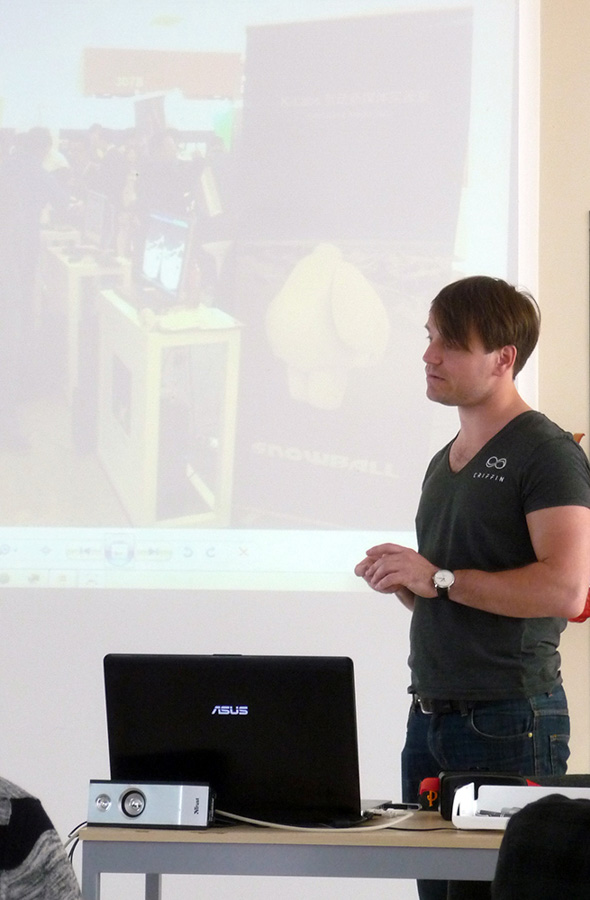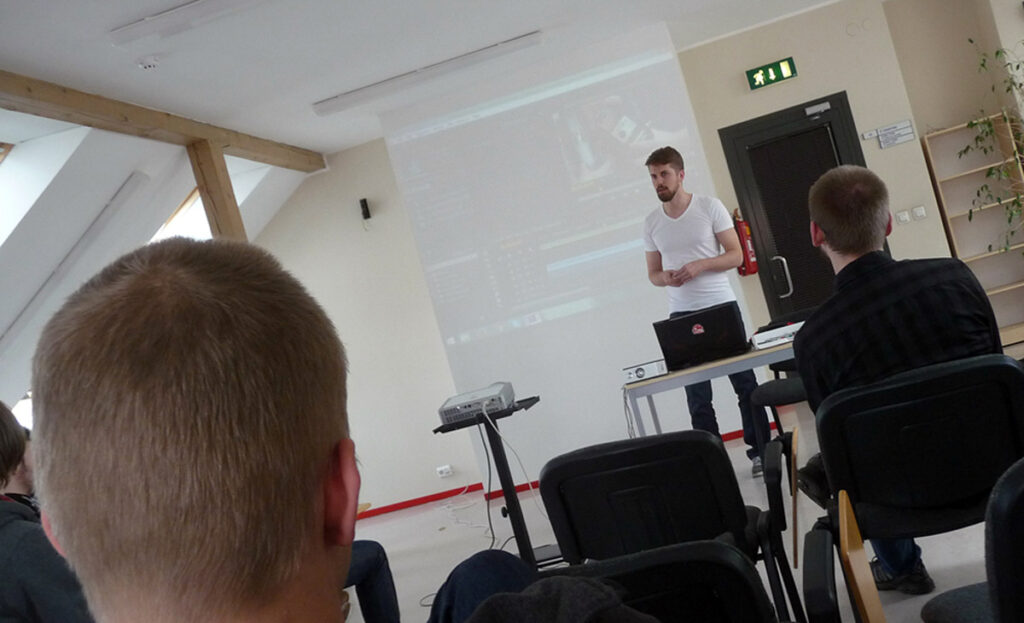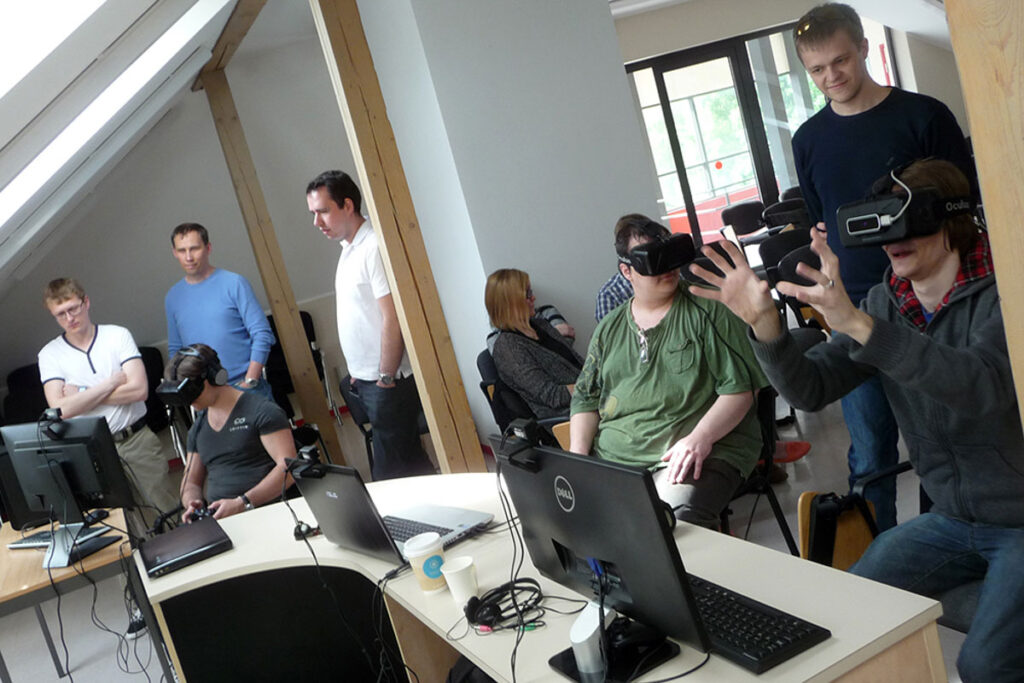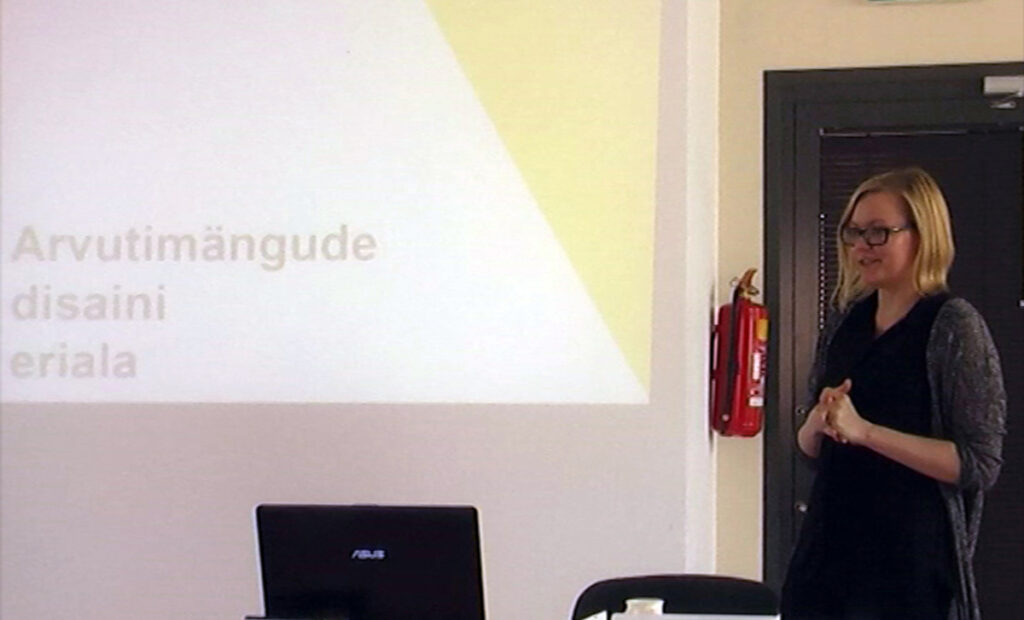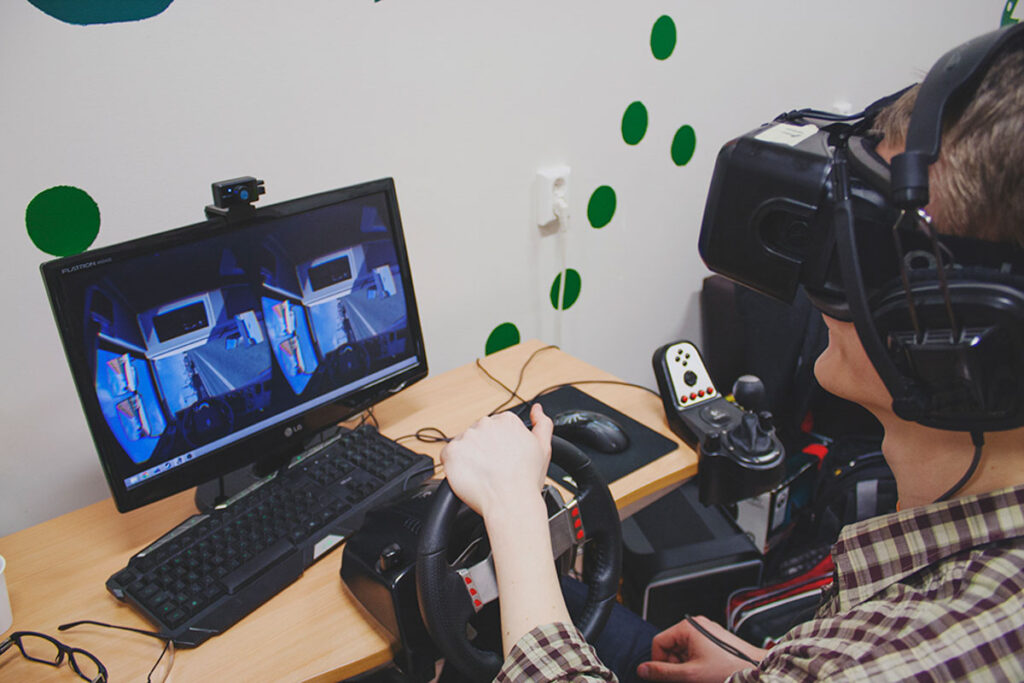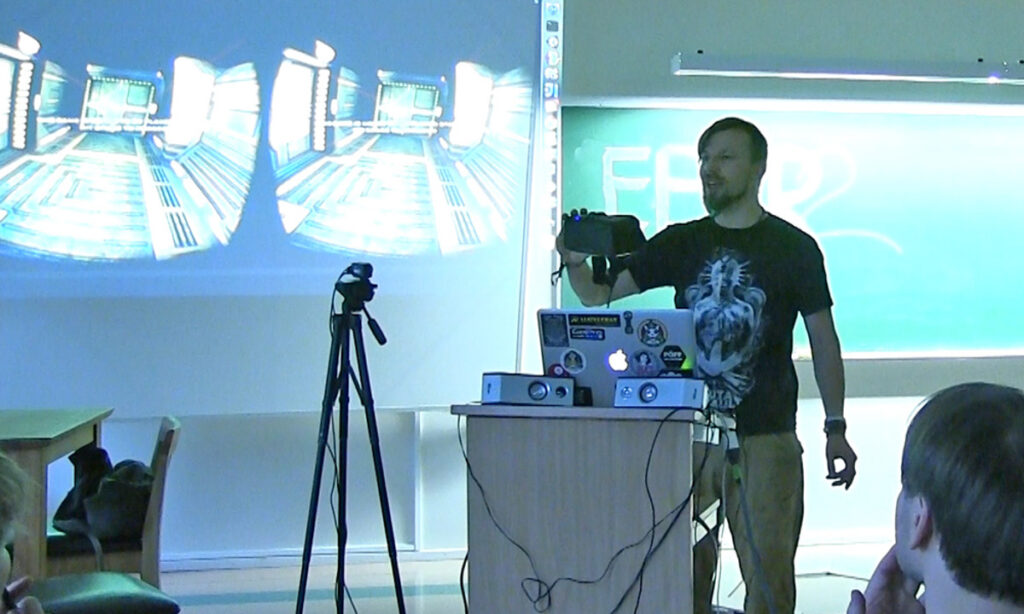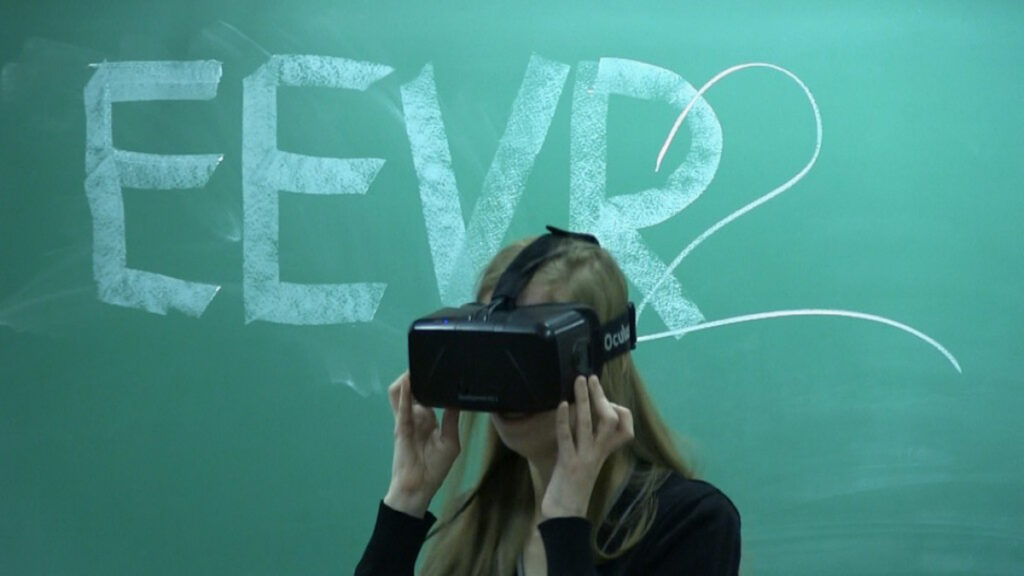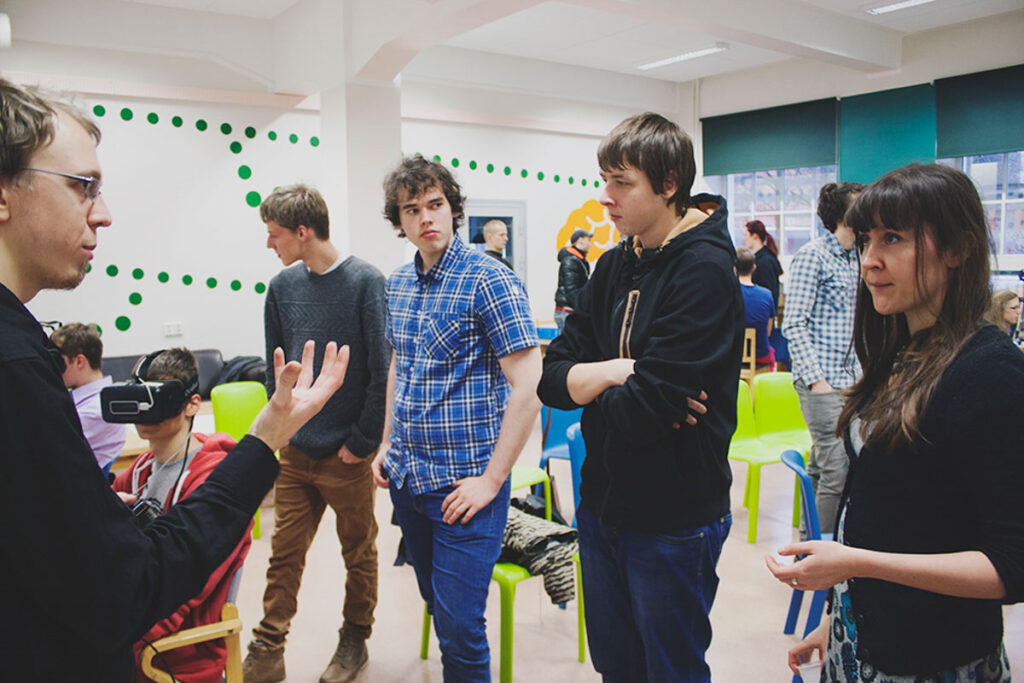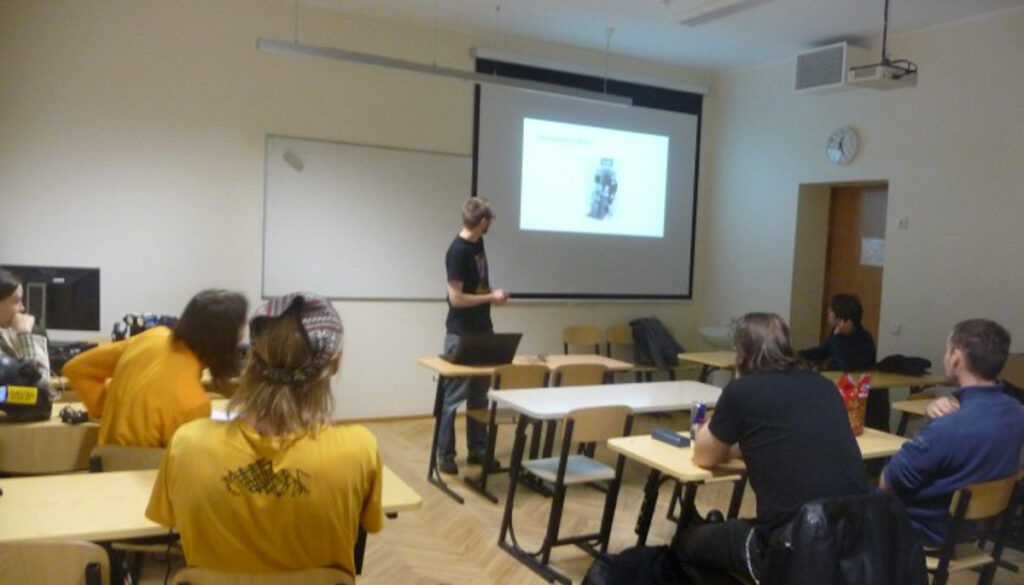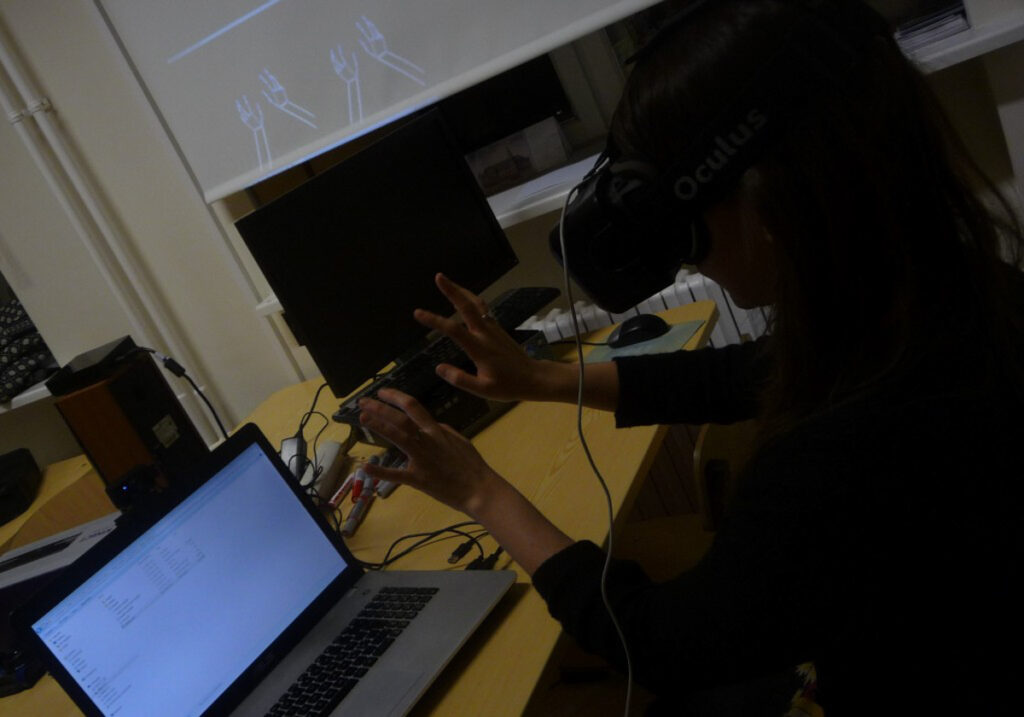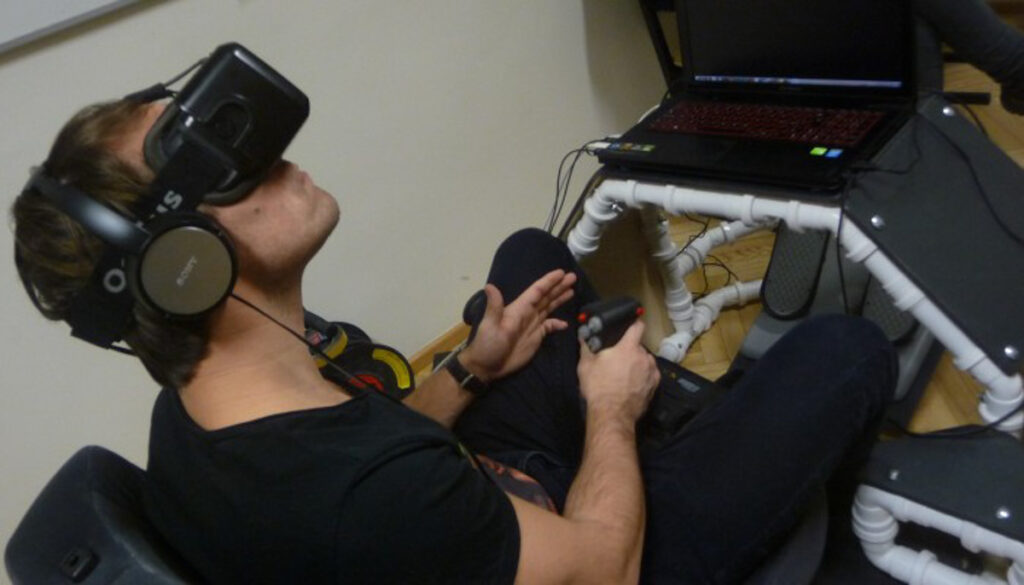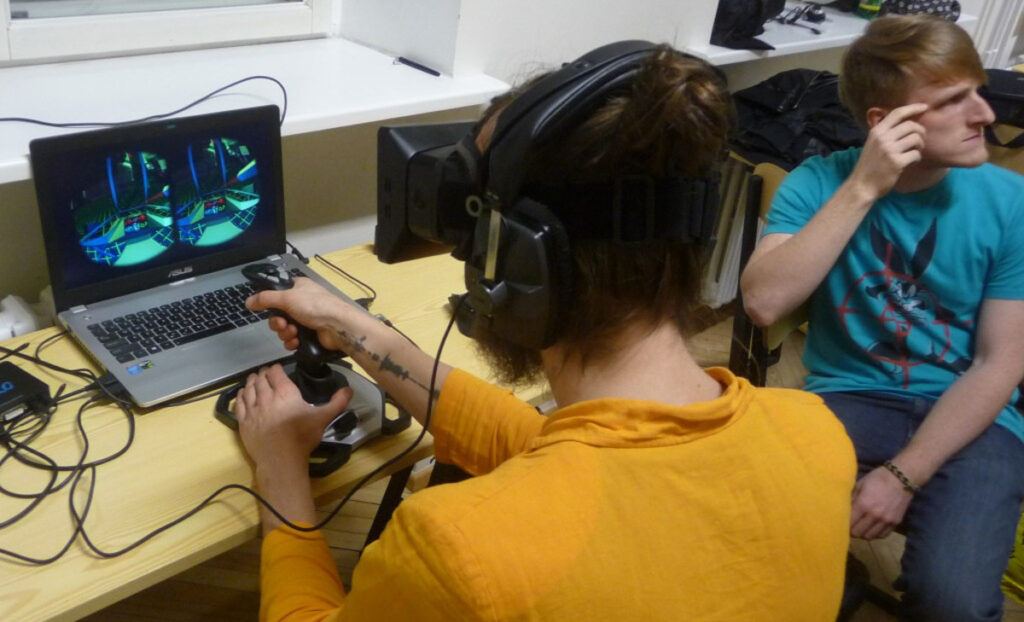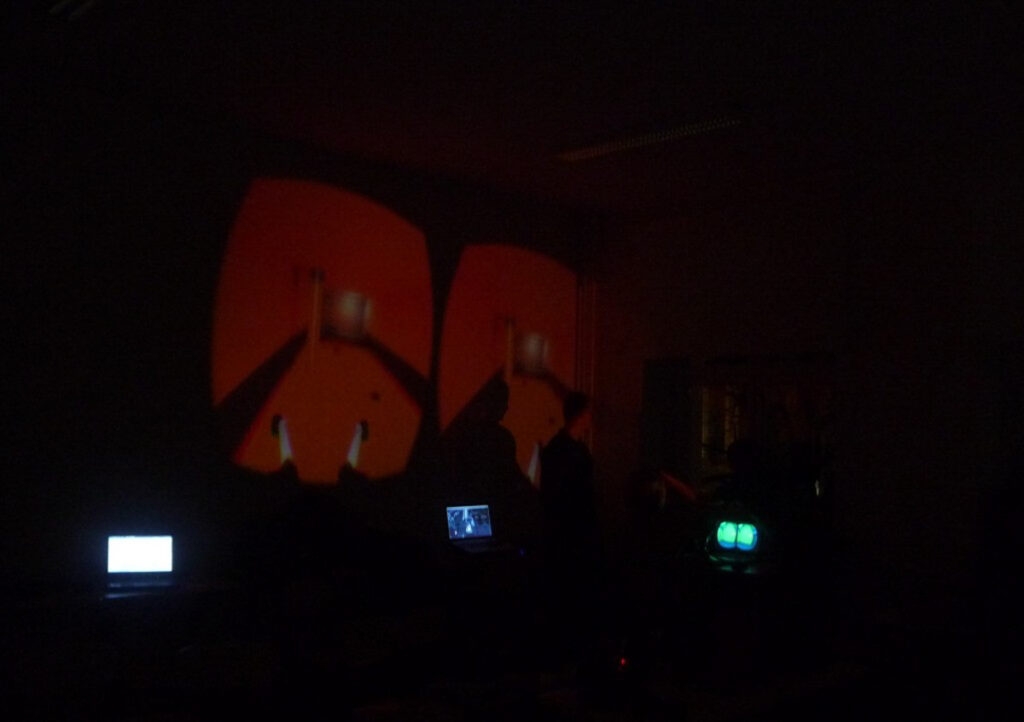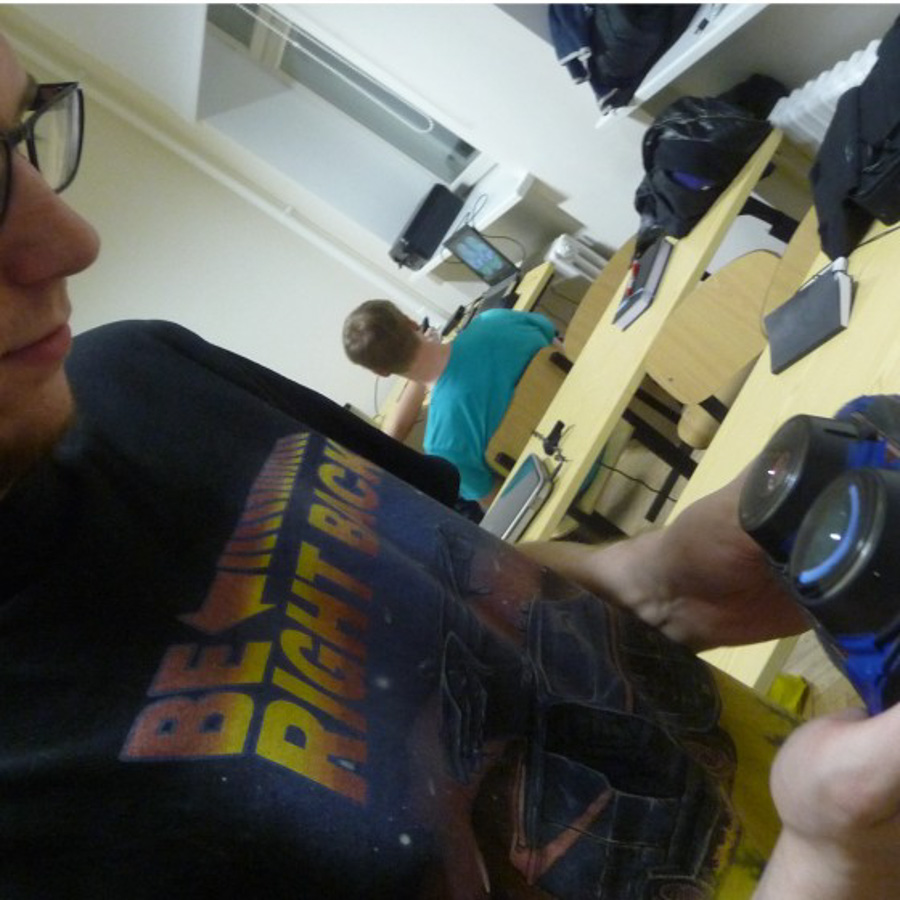The 4th edition of EEVR brought together some 30 VR enthusiasts from all over Estonia to discuss the latest news, share experiences and spread VR know-how. This time the menu was extra-packed with four different presentations and two demo sessions!
First up was Kristi Ramot from Mainor, introducing the all-new game designer course starting this spring. The basic outline of the study program was given and many interesting questions and new ideas were raised. The overall goal of the new program is to train people who would be capable of leading a game project from beginning to end. This entails some knowledge from programming, design in general, business etc.
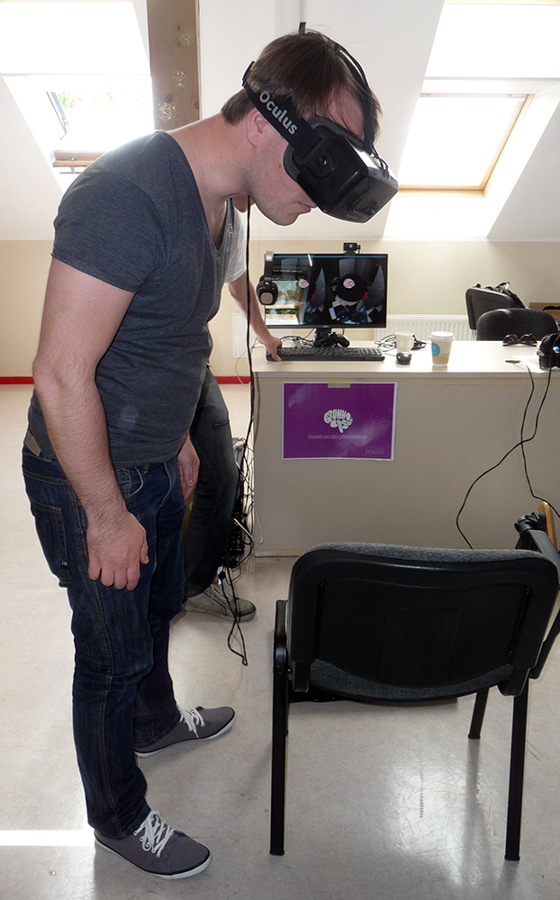
Next up was Criffin‘s Peeter Nieler, sharing some insights from a recent trip to Unite 2015 in China. The conference had a dedicated VR day, where Peeter also took the stage. After trying many different tech demos, the general conclusions were as follows: China is flooded with Oculus knock-offs and haptic chairs. On the one hand there is no real innovation, but on the other hand everyone is doing their own thing, so it definitely an interesting scene up there. And the ergonomics of chinese headsets is terrible for westerners (-: (emphasis on the nose).
After Peeter we heard a talk from Siim Raidma on VR game design and porting. He has been hard at work developing his still unnamed “hamsterball-death-ray-battle” game and porting some other beautiful (and terribly un-optimized) experiences to VR. He shared some key point for avoiding cyber sickness – avoid any g forces! His own project is a perfect example how this can be achieved with smooth floors, no walls and gentle turns. Yet the gameplay stay engaging. The bigger idea behind the battle game is of a VR e-turnament. Stay tuned!
The last presentation was about VR video by Rein Zobel. He attended a “quick and dirty VR video” workshop in neighboring Finland and brought back some interesting insights about 360 video capture. His project was about making a 360 film with just a single DSLR camera (Canon C-300 in his case). Sounds impossible? Rein and his team solved the problem by first capturing the whole panoramic scene as a still frame. Then they captured all the moving portions one by one with the same camera, always following the action. The last step was to merge the two into a semi-seamless whole. It worked amazingly well! This technique will obviously not work in every situation, but as a low-cost entry point to VR video it sounds perfect. The most expensive bit was the software used to make the panorama in the current project. Check out the end result here.
During all the talks it seemed that the VR lingo is expanding at a mind-boggling pace. Here’s a quick test to see how hard-core VR enthusiast you are. Try to find the hidden meaning in the following sentences: “I think this lighthouse thing is awesome. Have you seen the magic leap motion slam? I don’t believe in tango.” Check your answers from our dictionary 🙂
The demo sessions featured some local software (curtesy of Psychobus), triple-A titles (on behalf of Mario) and also interesting mobile headsets straigh from China (thanks to Criffin).

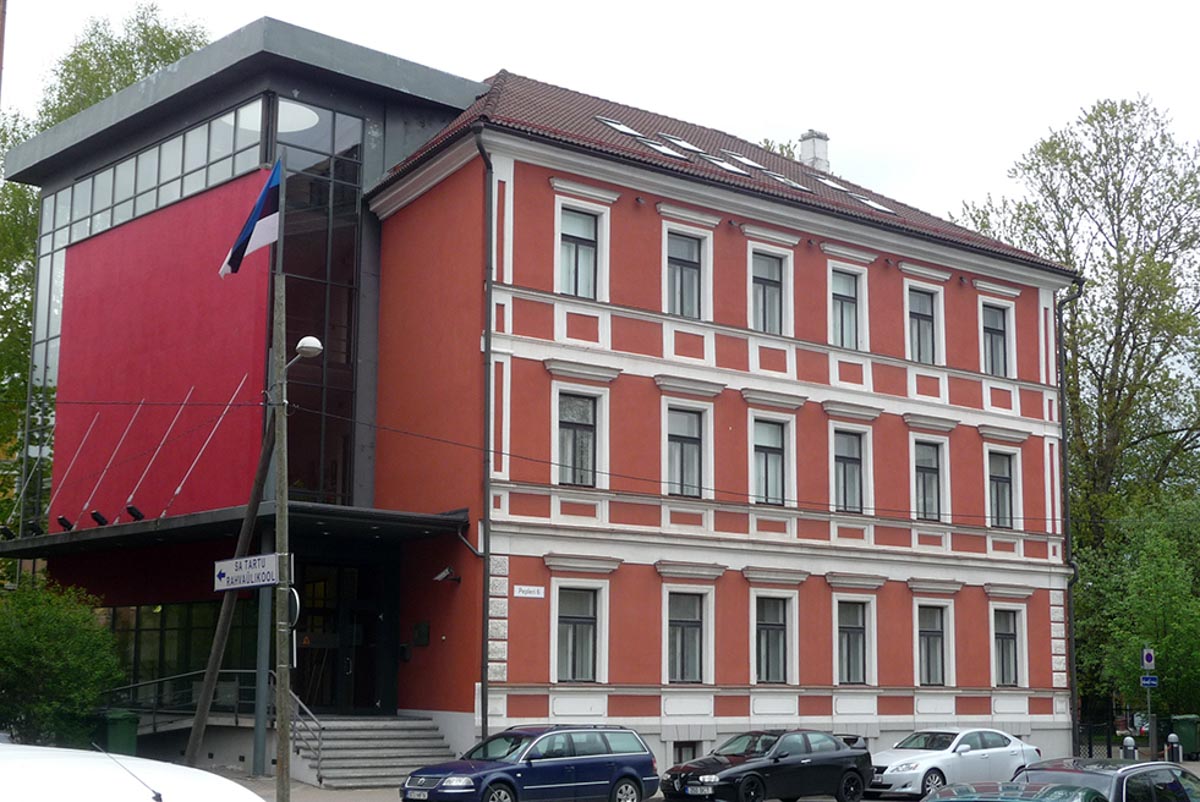
The next EEVR is closing in! The fourth gathering of the fellowship of the Rift takes place june 6th in Tartu, Estonia. This time we have partnered with Estonian Entrepreneurship University of Applied Sciences Mainor, both in terms of content and location. The program begins already at 11 am with the introduction to Mainor’s upcoming game design course by Kristi Ramot. At 12 we’ll have a short demo session to bring all the new people on board the VR train. At 13 sharp we’ll venture into the VR geek territory with cool talks from Siim Raidma (“VR: porting and game design) and Rein Zobel (“VR video”). After that we’ll do another round of demos until 17 pm, roughly. We welcome everyone – developers, artists, students, academics, entrepreneurs, wantrepreneurs or simply enthusiasts!
Full address: Pepleri 6, Tartu, fourth floor penthouse.
Sponsors: Mainor, Criffin, Psychobus
Recap of the last event – http://www.eevr.ee/?p=269
The community – https://www.facebook.com/groups/estvr/
FB event – https://www.facebook.com/events/892588827446459/
Meetup – http://www.meetup.com/EEVR-Estonian-Virtual-Reality/events/222501538/
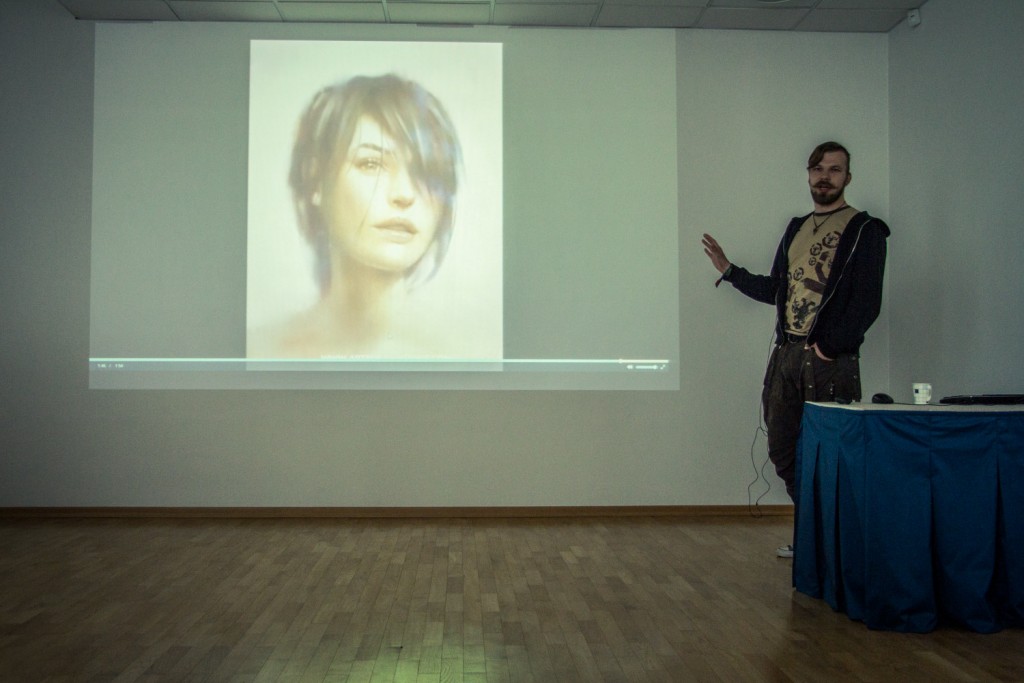
In the wake of EEVR IV it is only appropriate to finally do
a recap of the previous event. It was a sunny saturday in april that many of us decided to spend indoors (physically at least) with some great talks and interesting demos.
First up was Madis Vasser and his travel journal from the IEEE VR 2015 conference in France. Throughout his talk Madis tried to find the answer to the question: “Where lies the correct perception of reality?”. Is it in the brain, does it show up in academia, or is it possible to produce it through technology? If these questions sound interesting, see the hour-long video (in estonian).
Next we had a spontaneous speaker Filipp Keks, who shared his thought about game design, programming and life in general. Can thinking like a painter benefit us all? Yes, yes it can:
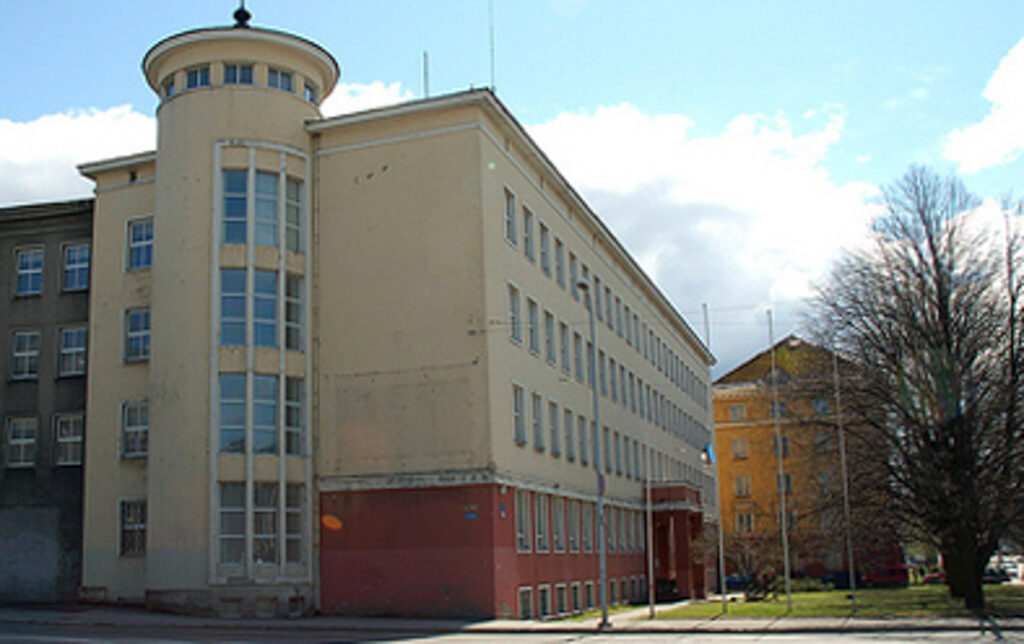
Better late than never!
EEVR III is just a few days away, happening on saturday, april 11th at Tallinn. More precisely: Tallinn Polytechnic School (Pärnu mnt 57), starting from 12:00
What’s in store this time around? As an EEVR tradition, Madis Vasser will take the stage and talk about his week-long trip to the recent IEEE VR 2015 conference in France and share the latest trends happening in the academic side of VR. Expect interesting research papers and weird gadgets (example video below). For the second talk session we will either have a group discussion about the upcoming games night (MängudeÖÖ) event or a surprise guest.
Preliminary schedule:
12:00 meet’n’greet
12:15 First talk session (IEEE VR)
13:15 Second talk session (TBA)
14:00 – 17:00 Demo time! Including:
* Elite: Dangerous – https://www.youtube.com/watch?v=G4EAZBvMSL8
* Alien: Isolation – https://www.youtube.com/watch?v=6Sn5TgJZCIs
* Unreal Paris – https://www.youtube.com/watch?v=ZGGPQKBfLxc
* Weightless – https://www.youtube.com/watch?v=dmpr6OSCz-c
* World of Comenius – https://www.youtube.com/watch?v=9YiGAR0JDt0
* VR Lab Rats – https://www.youtube.com/watch?v=2_a3Eha1Ya4
* And many more
Recap from the last event – http://www.eevr.ee/?p=175
Contacts: Mario Saarik / Madis Vasser (madis@psyhhobuss.ee / 53950310)
FB event: https://www.facebook.com/events/1573775006237030/
Meetup event: http://www.meetup.com/EEVR-Estonian-Virtual-Reality/events/221555364/

Undoubtedly EEVR II was a blast. With three presentations, 30 people and a room full of different hardware and software demos, the Estonian VR community was in for a real treat this time around. New ideas were shared, new acquaintances met and new realities experienced. Pictures from the event can be found here (by Kertu Saar), video below.
First up in the talking sessions was soon-to-be-MSc Madis Vasser with a quick overview of the status quo of VR in psychological science and at Tartu University. He demonstrated the flood of different headsets on the market, yet there seems to be less focus on accompanying software. He and a team of fellow students are working on a solution to bring researchers with less programming background closer to VR with a toolbox that makes creating virtual experiments much easier. Madis will most likely also attend the IEEE VR conference in France this march, so we’ll make sure he keeps a proper travel diary while abroad. For more info, shoot a message at madis.vasser@ut.ee.
Next things got really nostalgic and futuristic at the same time with tech entrepreneur Peeter Nieler on stage. He drew a clear distinction between virtual reality environments and the means by which to experience them. With a short history lesson the audience got to see the parallel progress in both fields that now have begun to finally merge properly. Peeter also pointed out some reacurring names in the process, like Ivan Sutherland and John Carmack. Then the time was right to reveal his own plans for the future – making man run in virtual reality. More precisely, the Criffin RunPad. He went over the many concepts and prototypes that were tried before settling on a simple and effective solution (not shown here until the proper time). A fortcoming full-body tacking system was also briefly discussed. Those interested in more detaild information can get in touch: Peeter.Nieler@criffin.com
The final talk was from a full-time game dev Filipp Keks, who is well known in VR circles for his EvilMech Runner. The problems and lessons learned from that demo was also the main topic of Filipp’s presentation, most of it happening inside Unity game engine. We discussed the different solutions to issues like walking through virtual walls, cheating the step detection algorithm and staying in camera range while in VR. Filipp pulled together different clues to suggest that Oculus is heading in the direction of a standing experience with the consumer version of the Rift. He finished with a call for action to all the developers to help make his freely available code better. Follow the link: https://github.com/taphos/oculus-natural-movement.
The demo sessions can be summarized with the words of one of the participants: “I have never seen so many Oculus Rifts together in one room!” Criffin had their latest prototypes on display for anyone to try out, this included a full body tracking system and two cool RunPads (ideally suited for Filipp’s EvilMech runner!). Madis held the first public test of his change blindness experiment, where one must spot changes in a virtual room (a devilishly difficult task), somewhat resembling Sightline: the Chair demo. Siim Raidma was back once again with his laser turret battle, this time with added multiplayer support! People were also stunned by Ambient Flight and couldn’t get enough of paragliding over the mountaintops (wind effects included). Keeping things down to earth, Keijo Koort brought out his impressive collection of driving games from Euro Truck simulator to Project Cars and Assetto Corsa. One players was so immersed he nearly killed the gear shift. Also, the funky music from a cool top-down shooter Nighttime Terror filled the room constantly. After three hours of fun and games people were ready to return to present reality.
Many thanks to UT Idea lab for the most awesome rooms in town, Criffin for the snacks and Psühhobuss for various logistics.
Now start preparing for EEVR III in early april (probably)!

It has been a long time coming, but the second installment of EEVR is finally just around the corner, taking place this saturday (7.02) at noon in Tartu. EEVR is a non-profit gathering of estonian virtual reality enthusiasts, researchers and developers.
Venue: Idea Lab of Tartu University, Narva mnt 4. Enterance through the main door, plenty of parking space.
Preliminary schedule (details below):
12:00 Experiments with the coffee machine
12:30 Talks by Madis Vasser, Filipp Keks & Peeter Nieler
14:00-17:00 Demo sessions with Oculus Rift & Google Cardboard
About the talks:
* Madis is a psychology student focusing on VR related research topics. His current work is related to attention (and lack of it) and making VR more accessible to researchers via an Unity toolbox under development (in collaboration with the IT department).
* Filipp is a professional game developer and VR enthusiast. He is an author of the legendary EvilMech Runner Oculus demo. Lately he has also been messing around with photometric 3D scanning.
* Peeter is an VR entrepreneur and all we are currently allowed to share about him is this:
About the demos:
* Take part in a psychological VR experiment
* Settle the score in an unreleased 1 vs 1 armed laser turret battle game
* Try the visually most stunning experiences available (i.e Senza Peso) on dedicated VR machines
* Bring Your Own Demo!
Recap of the last time: http://www.eevr.ee/?p=122
The event is generously sponsored by Psühhobuss and Criffin.
Contacts: Mario Saarik / Madis Vasser (madis@psyhhobuss.ee / 53950310)
FB event: https://www.facebook.com/events/957375797620919/
See you on saturday!
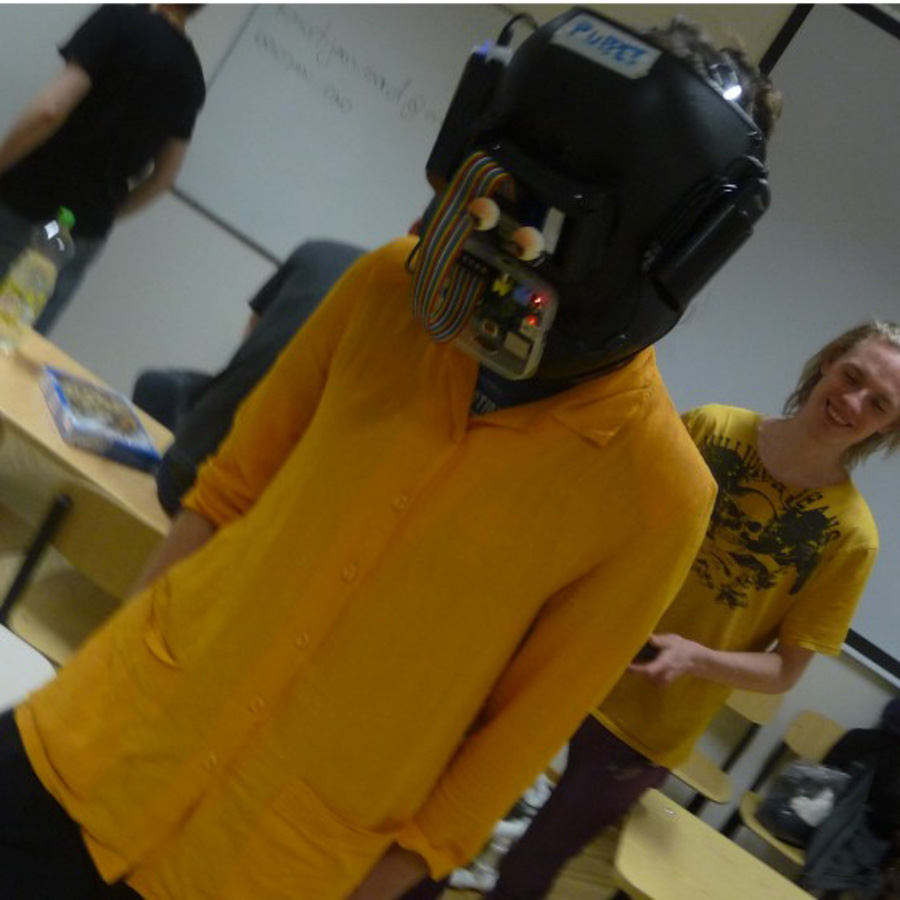
28th of november 2014 saw the first ever EEVR meetup in Tallinn. There was a great mixture of people from 3D artists, game devs and engineers to general enthusiasts. All in all, about 15 people attended the proof-of-concept event during five hours. We had two planned talks and much discussion, also some really awesome hardware/software demos.
In the intro talk the organizers Mario and Madis talked about the concept behind the event – to get people connected, share knowledge, discuss latest VR news and also boost the development of local VR software/hardware. Humble goals indeed 🙂
Madis Vasser then discussed the different aspects that make up a stress-free VR demonstration. In short: know your hardware, location, software and audience. He highlighed some big mistakes one can do in a demo setting, like placing your laptop in direct sunlight (performance killer) or letting players accidentally smash themselves into various real objects while inside the rift (fun killer). Special focus was also on the fear factor – how different age groups tend to react to VR. Children can be quite shocked, so it’s advised to communicate with them frequently. Older people are sometimes in “VR denial”, so expect lots of screaming from them.
Mario “Zuurik” Saarik took the audience down the memory line with a quick review of VR history, starting from the 1930s! The slideshow had something new for everybody, as the VR scene was much more diverse than anyone had expected. Some headsets were super cool, slightly funny or epic failures, others never even saw a proper release. The talk
smoothly transitioned to todays technological advances. People discussed different input devices and their limitations, the possibilities of waking in VR and also the elusive soon-to-be-seen Magic Leap technology. All in all, a solid two hours of discussions. Next were the demo sessions.
Madis Vasser demonstrated the uncanny valley effect with a all-too-real looking 3D scanned self-portrait demo, done with the help of DollyMe3D. The players could see him run around, creep uncomfortably close or just mirror the headmovements of the rift to really mess with the senses. Madis also let people experience the presence of hands in VR through a rift-mounted Leap Motion and different demos found from the web.
Zuurik brought out his War Thunder cockpit –
complete with a joystick, steering pedals and throttle lever. Those who tried it were impressed – despite the crazy in-game dogfight and upside down manouvers the whole experience felt comfortable and quite immersive.
Siim Raidma premiered his special build for EEVR I called Ball Turret. In the game you are a Turret pilot that sits, well, inside a ball. The virtual world is TRON-ish, with a seemingly endless flat surface beneath and a city of blocks above. Your job is to roll about and shoot different targets high in the sky. The game relies on a joystick for movement and fire commands, the aming is done with head movements. Although rolling around in a giant ball might sound nauseating, the actual experience was super-comfortable. Drifting sideways was the most fun I’ve had in VR since the barrelrolls in Great Power demo.
We didn’t have the planned hackaton due to hardware issues, but Madis filled the gap with his DIY VR viewers (one made from a tea box, the other simply from cardboard and foam). Ott Pilipenko also brought his legendary Puppetmaster, so people could take turns controlling each others minds.
The evening presented many opportunities for networking with fellow enthusiasts. Some where looking for a job, others were offering jobs. In summary, the first event was a great success and the next one can only get better, as we already have some sweet talks in mind. Many thanks for Psühhobuss for providing all the snacks and Tallinn Polytechnic School for the nice
rooms.
The next event will most likely take place sometime in the end of january 2015 in Tartu, Estonia. Who knows, maybe in a form of a VR jam. Everybody, start your game-engines!

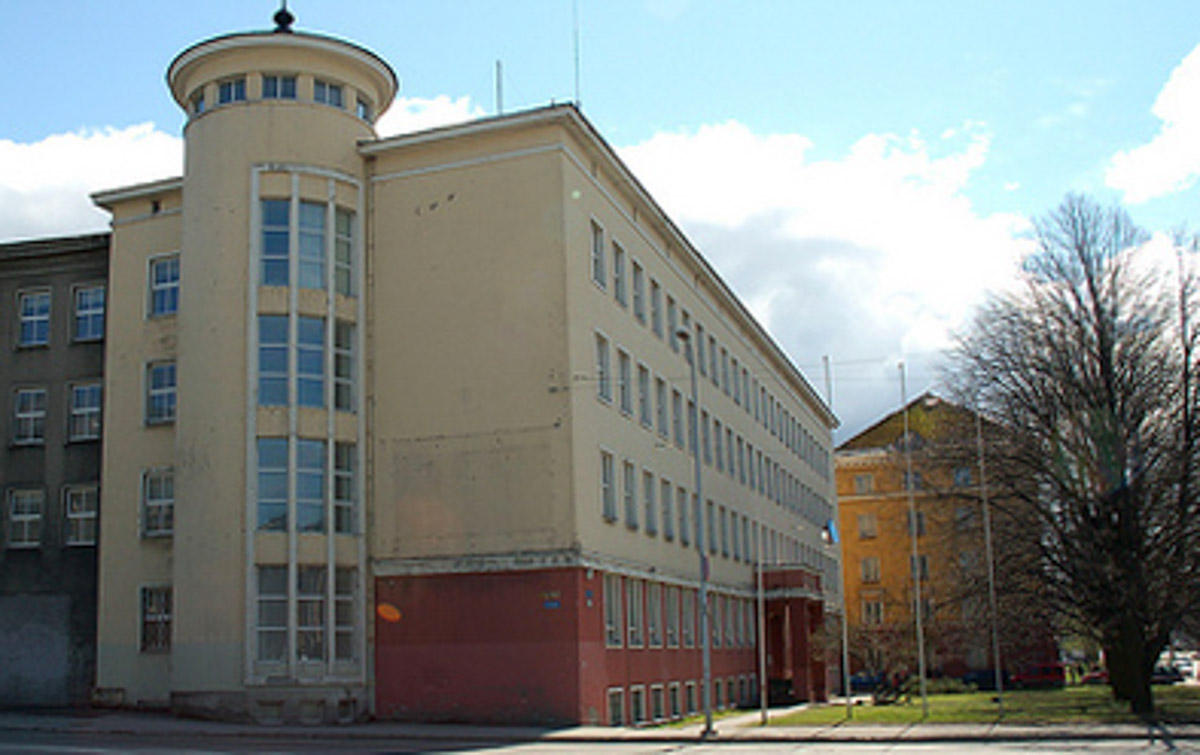
Time is going super fast and we are just a week away from the first ever EEVR meetup on the 28th of november! It is about time to look at the event in more detail:
Where: Tallinn Polytechnic School (Pärnu mnt 57, room A209)
Preliminary schedule:
15:30 time for setting up the demos
16:00 meet and greet
16:15 Quick introduction to EEVR (Mario Saarik & Madis Vasser)
16:20 Talk 1 – What VR headsets are out there? (Mario Saarik, in estonian)
16:40 Talk 2 – The psychology of VR, lessons from demo shows (Madis Vasser, Psühhobuss, in english)
17:00 Talk 3 – VR and education opportunities (Ivo Visak, in estonian)
17:30 Demo sessions! Some unpublished games and new leap motion VR experiences plus all the well-known VR “classics”.
19:00 Mini-VR-hackaton: combining the rift, kinect v2 and leap motion to bend space-time.
02:30 Watching the first Virtual Reality Awards live event through RiftMax (http://thevirtualrealityawards.com/)
We also try to film all the talks and publish them online in the coming weeks, so those who can’t make it in person can still catch up on the good stuff!
PS! Let us know ASAP, if you are bringing a rift and/or computer, so we can plan the logistics!
Contacts: Mario Saarik / Madis Vasser (madis@psyhhobuss.ee / 53950310)
Event: https://www.facebook.com/events/1573717002848704/
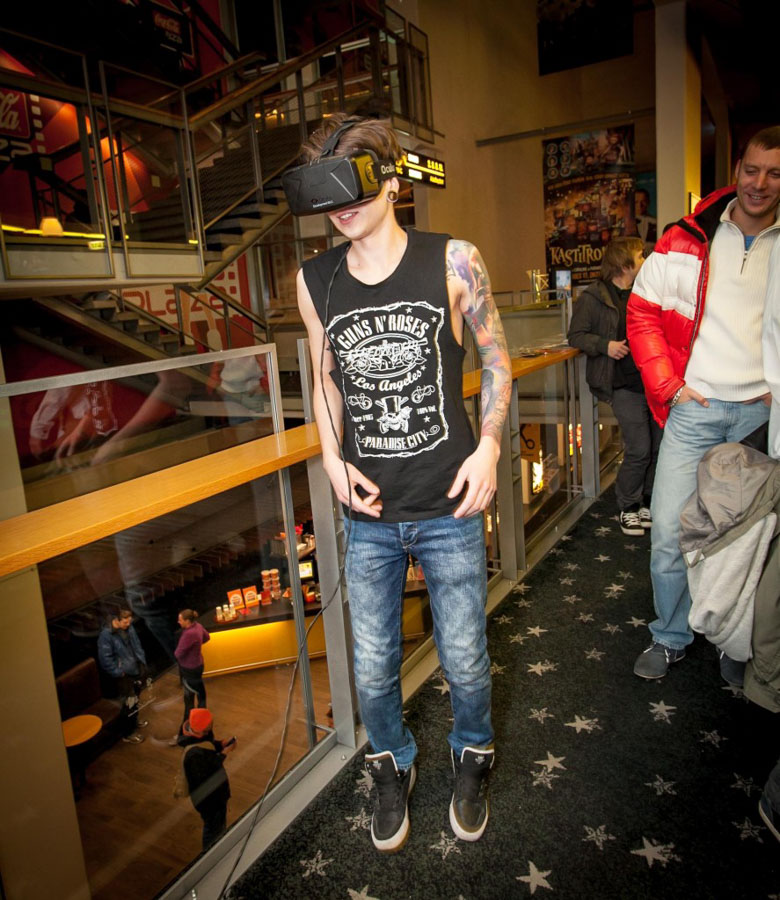

This past week saw the release of EvilMech Runner,
a small experimental survival game that we have mentioned before by estonian developer Filipp Keks, meant to achieve the feeling of natural movement with minimal hardware. This means in-game movement without the use of a gamepad/keyboard/treadmill, using simply the Oculus hardware and clever software. Since my first encounter with the game fell short due to the long que of people wanting to try the demo and me being able to get stuck in a virtual wall, I was exited to fire the game up at home.
Setup: as the readme file suggests, I put the Oculus IR camera about eye level on a tripod and stood (yes, this game is meant to be played while standing) about 1 meters away. I also had a small carpet on the floor to give me some feedback as to where I was located in reality (pro tip for playing alone). There is a need to press the spacebar key multiple times in the beginning. Make sure you press it until you see “RUN!”, otherwise you false-start and miss half the fun (the EvilMech part).
Experience: Two players tried the game, me and the wife. Neither of us fell over, but having your feet wide apart is definitely a smart choice. Some funky graphical glitches aside (water splashes in the ceiling), the experience was quite impressive workout-wise. Quote from one of us: “How am I out of breath in my living room!?”. The main selling point, step detection, worked very well, but of course one could also cheat by just bobbing the head up and down. There was a huge difference in playing styles however – while I managed to stay on the tiny carpet without problems, my other half took a much broader approach and constantly actually ran off in different directions. So, just in case you don’t want to yank your computer off the table, find a running partner to hold you back:)
I also caught up with Filipp Keks (“hopscotch” in estonian, quite approprietly) for some background info.
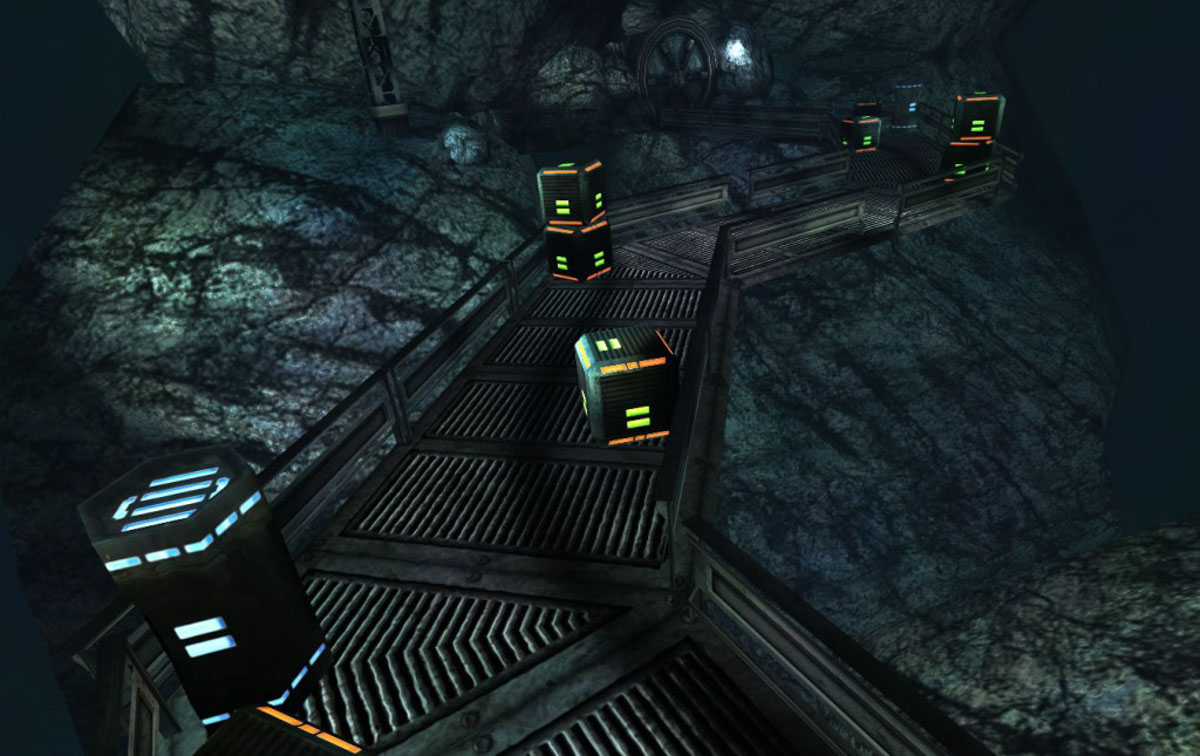
Where did you get the idea for this kind of solution?
The idea came to my head the first day I received my DK2 back in August. After trying first couple of demos I noticed that the motion tracker range is capable of much more then just “peering around corners” as it was announced. In almost any demo you can actually walk a couple of meters from the initial point. At the same time solutions like [Virtuix] Omni and Cyberith seemed a bit too over-engineered. I also tried to mix gameplay with a standard treadmill, but it limits you by speed and direction, so I rejected the idea and stuck with simple jogging in place. According to some fitness and medical sites I found, jogging in place is also quite healthy and beneficial 🙂 The disadvantage of my solution is that you can not turn back as you would block the tracker camera view. I worked around this problem by making the game forward running, so the player never have to turn back. Later it came out that Oculus developers are moving the same direction as they made the new Crescent Bay prototype with IR sensors visible from behind.
How easy was this approach to implement?
It took me one weekend. Most of the time I spent rewriting a part of the Oculus Unity driver. Version 0.4.2 was quite a mess, now 0.4.3 came out and it looks much nicer and logical. Currently I’ve rewritten the code for the latest SDK. I plan to release my code as open source so others could make more demos with the same type of gameplay.
Will this kind of movement control catch on?
Maybe not exactly – DK2 wasn’t designed for it after all 🙂 But this is definitely the direction where VR will be moving in the near future. Oculus newest Crescent Bay prototype has a wider position tracker range and IR sensors on the back which perfectly suits my idea of gameplay.
Lastly, what are your next plans?
I have plans to experiment with full body motion tracking using something like a Kinect. I also have a couple of ideas how to make the gameplay more interesting and unsusual, so stay tuned.
EEVR will keep a close eye on Filipp! If some of the readers are unable or simply lack the stamina to try EvilMech Runner, here’s the official gameplay clip
